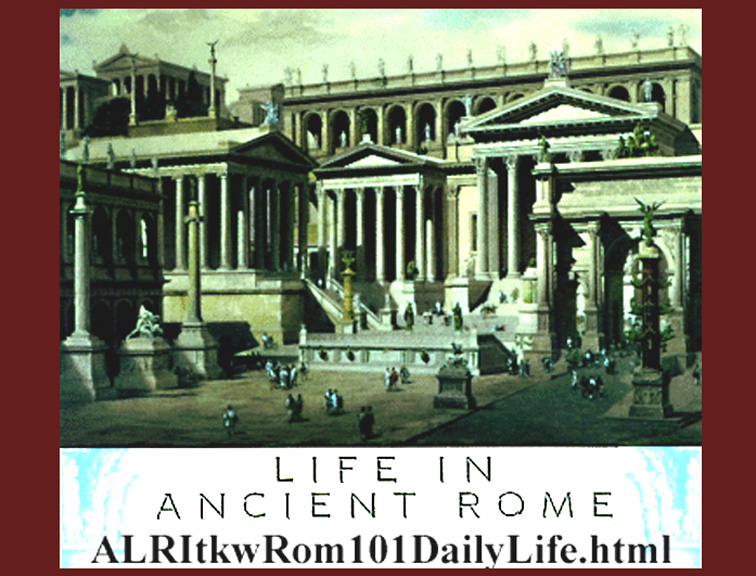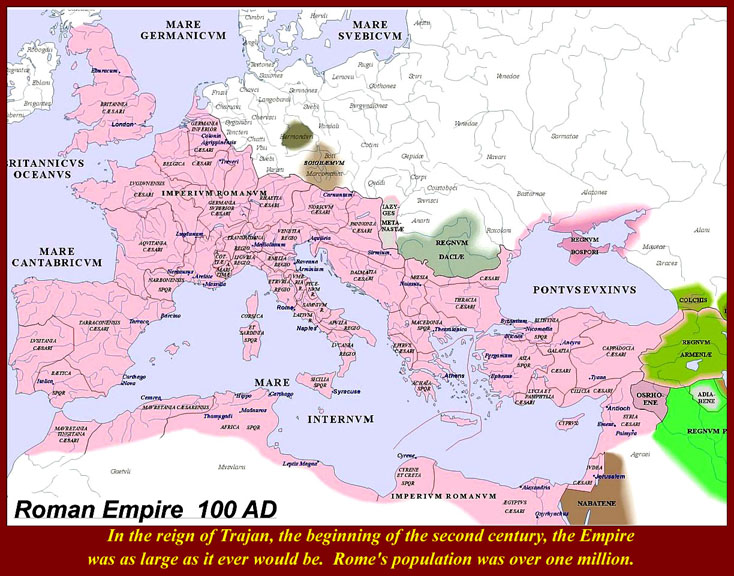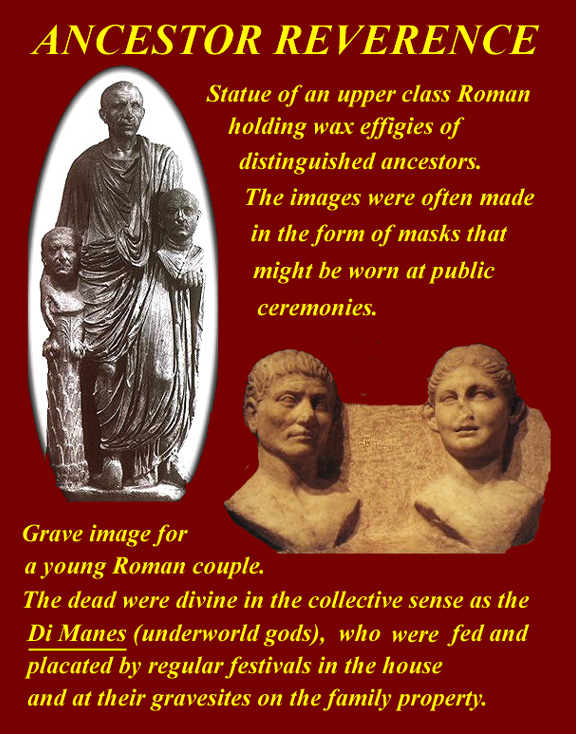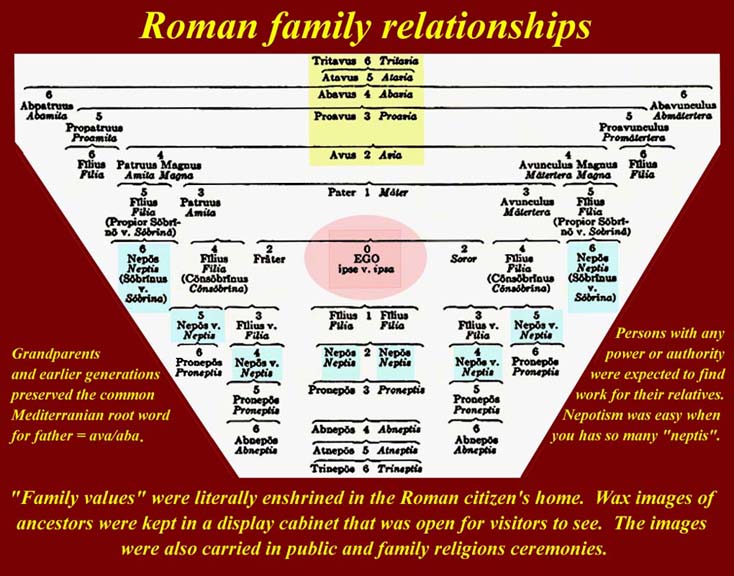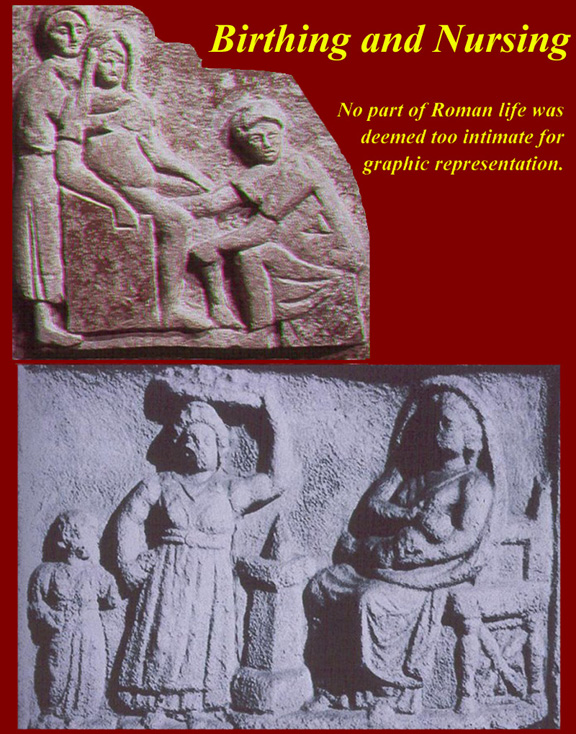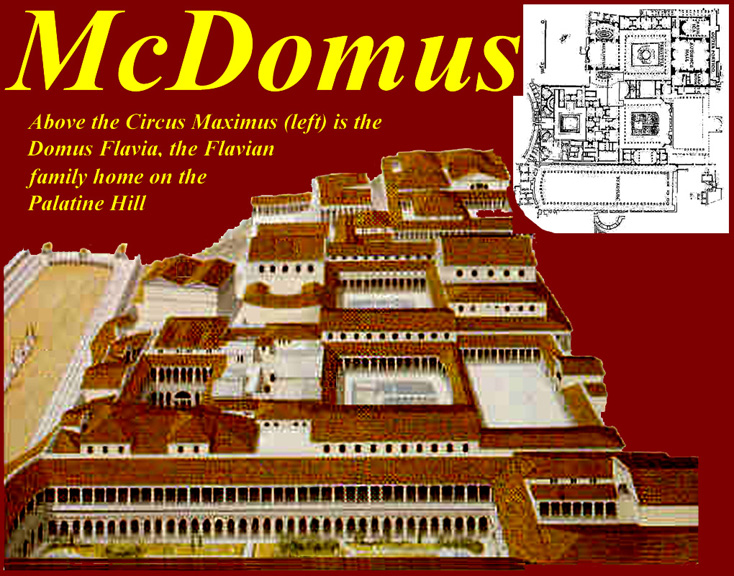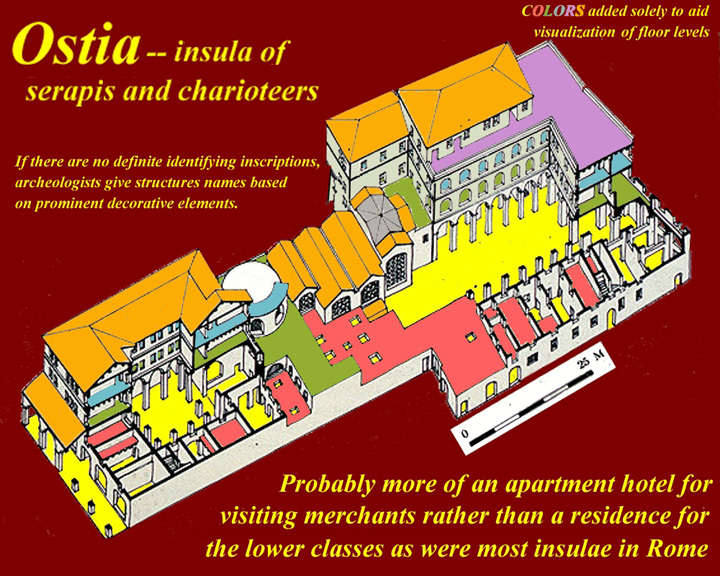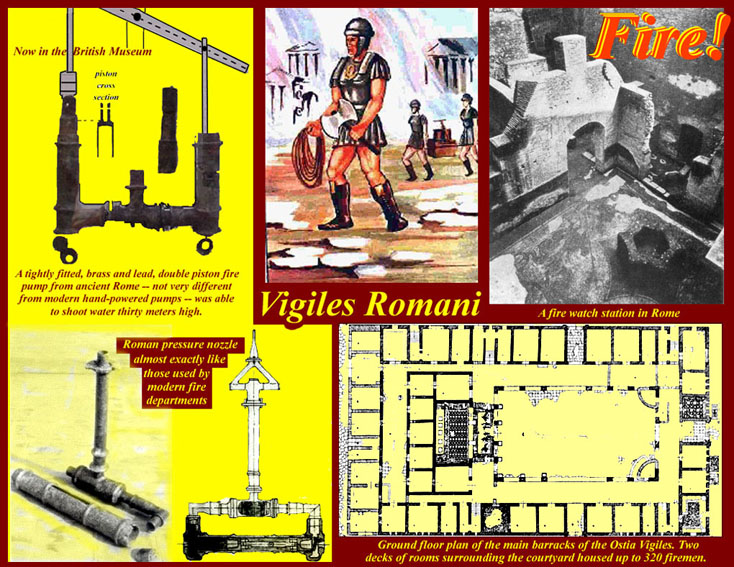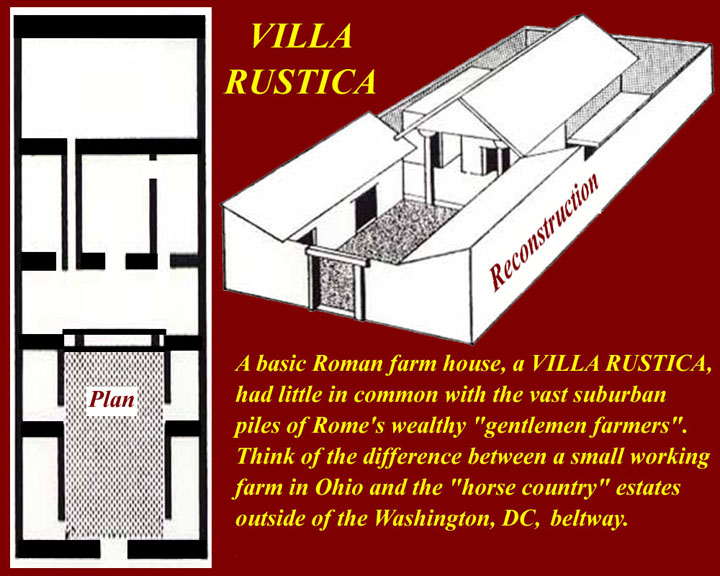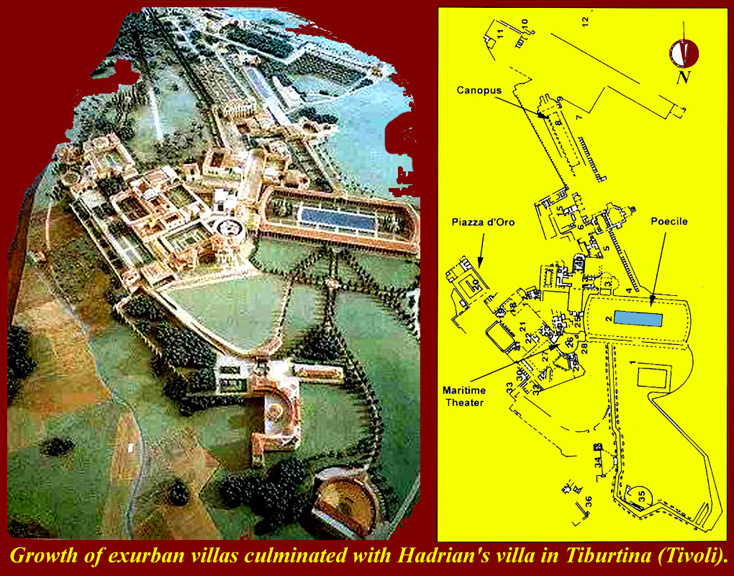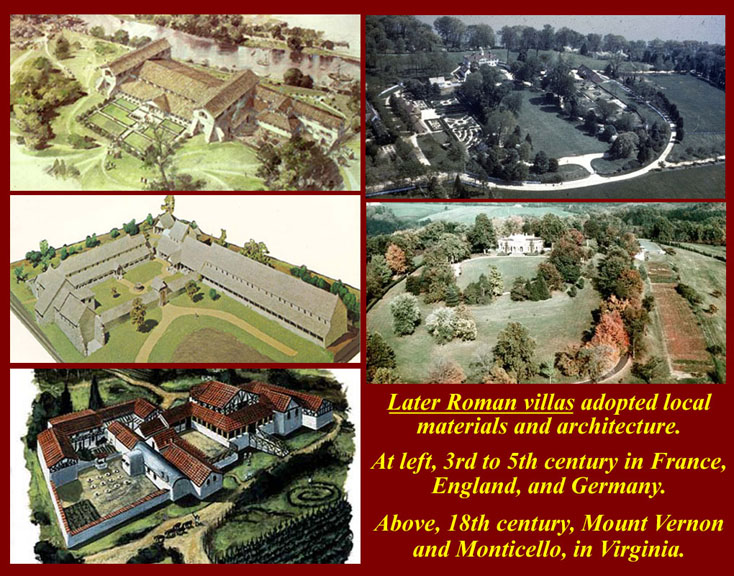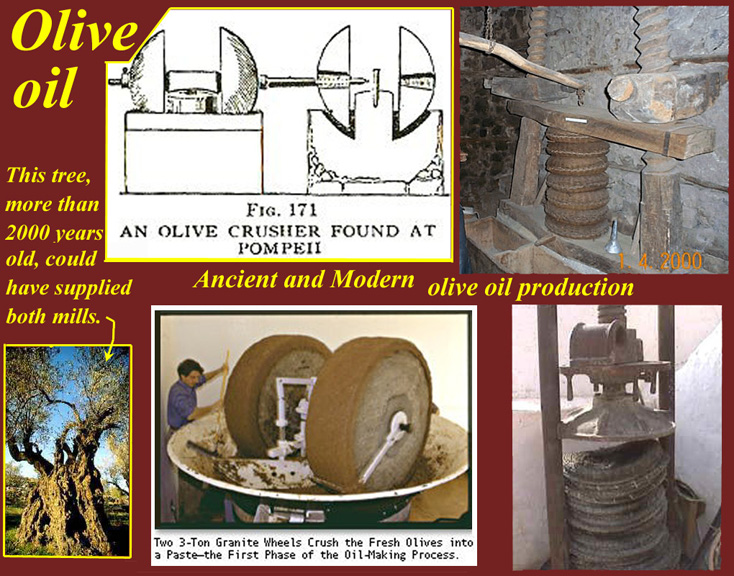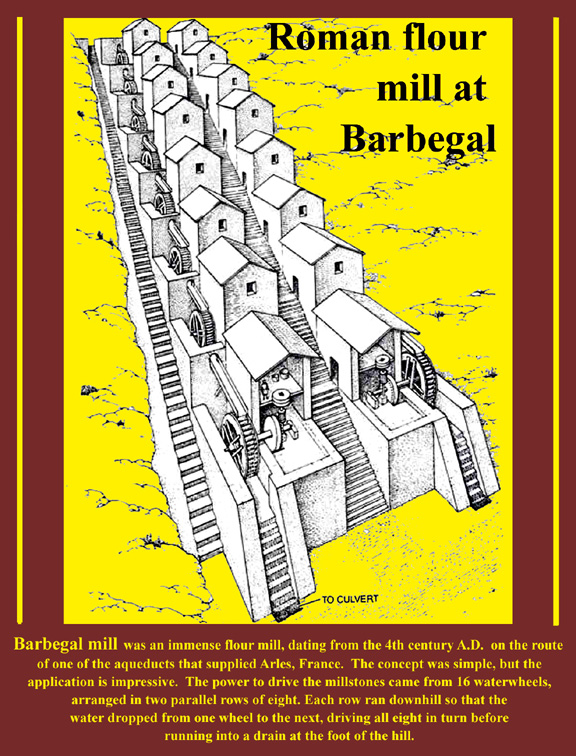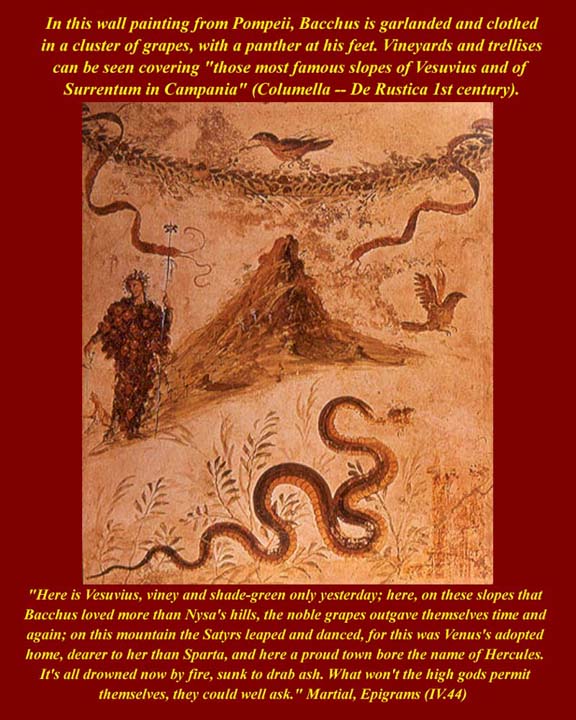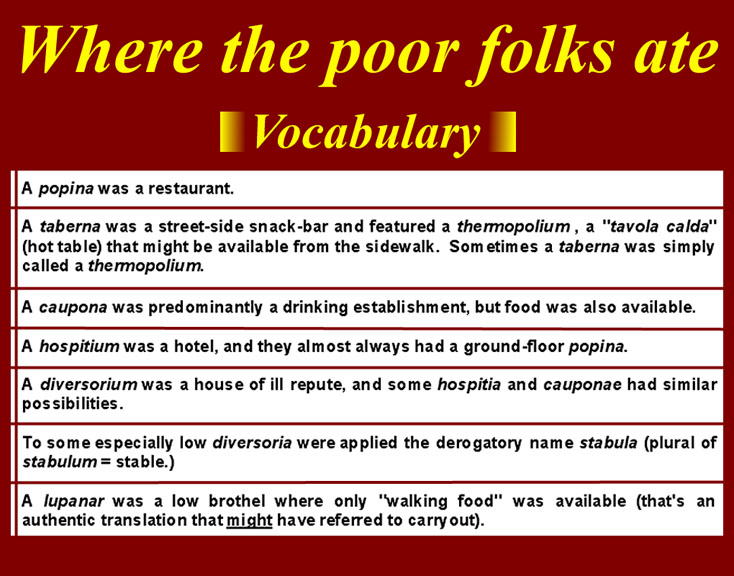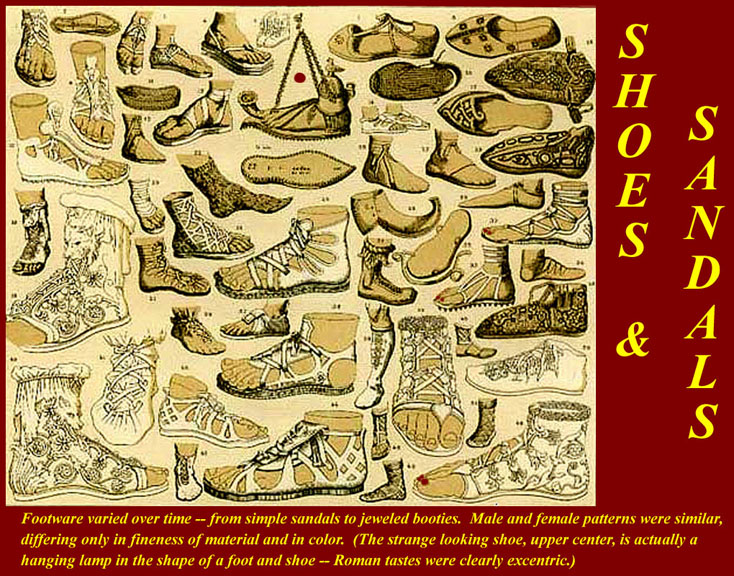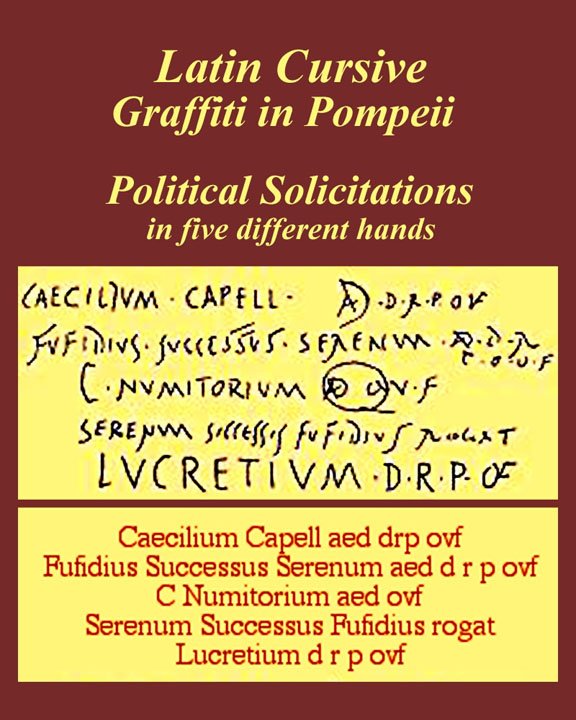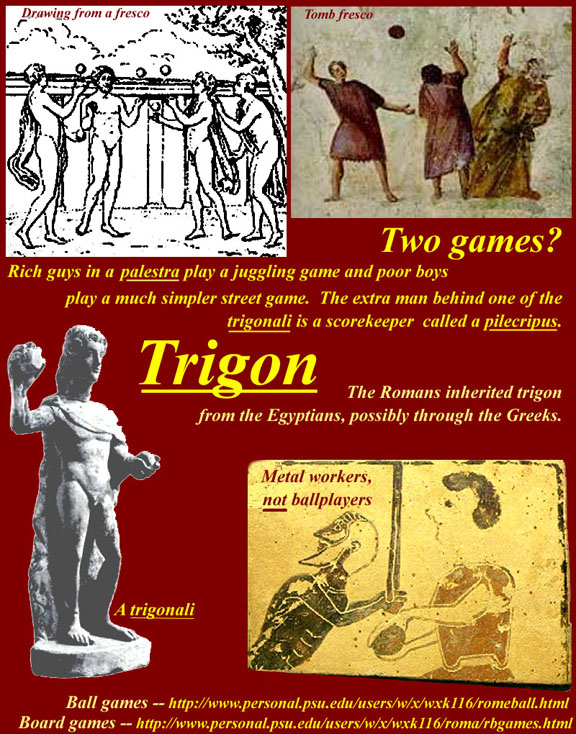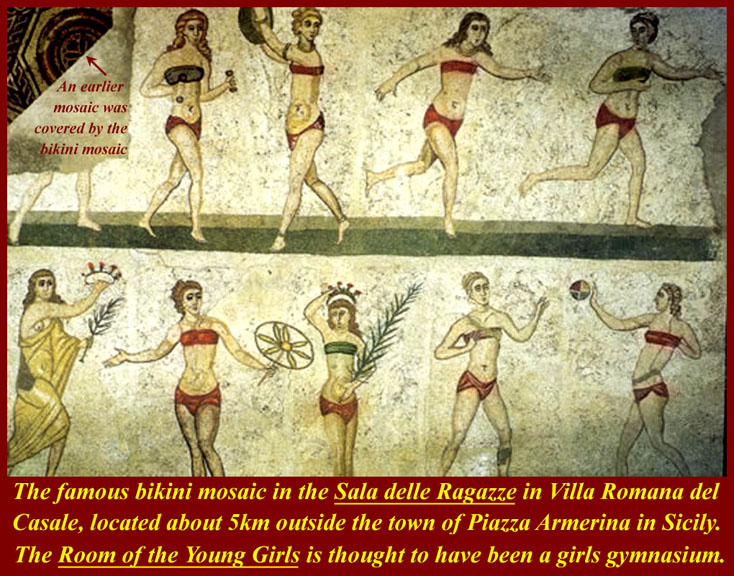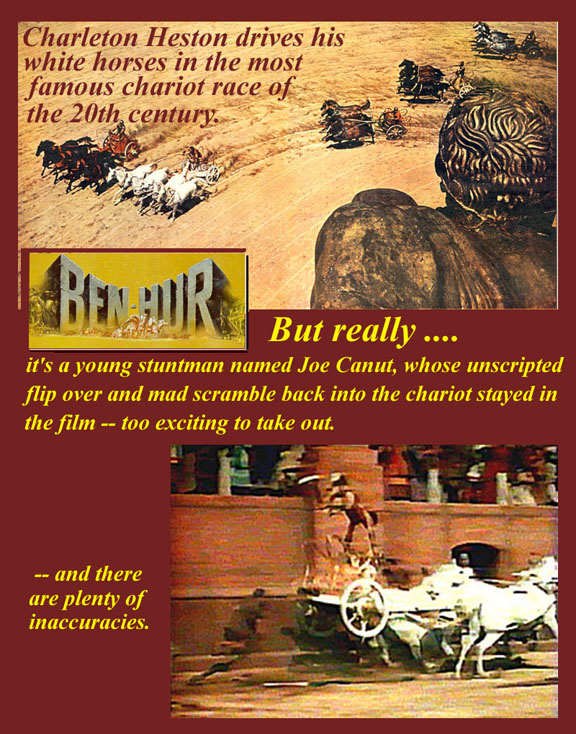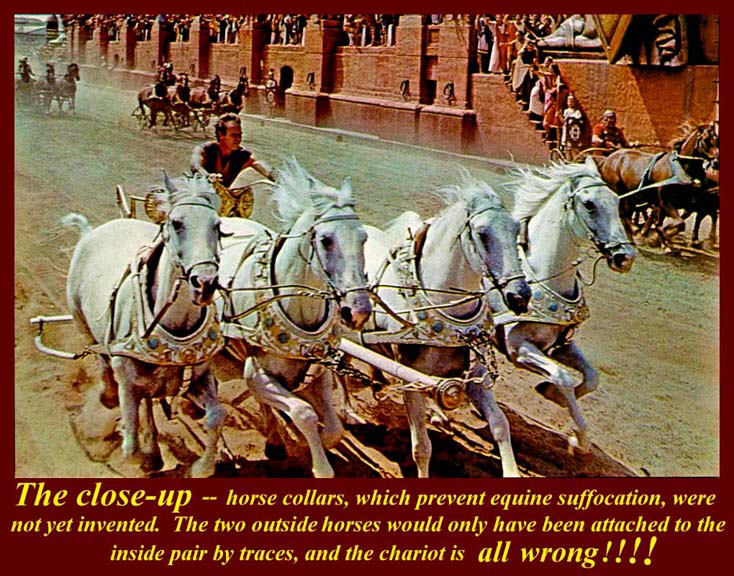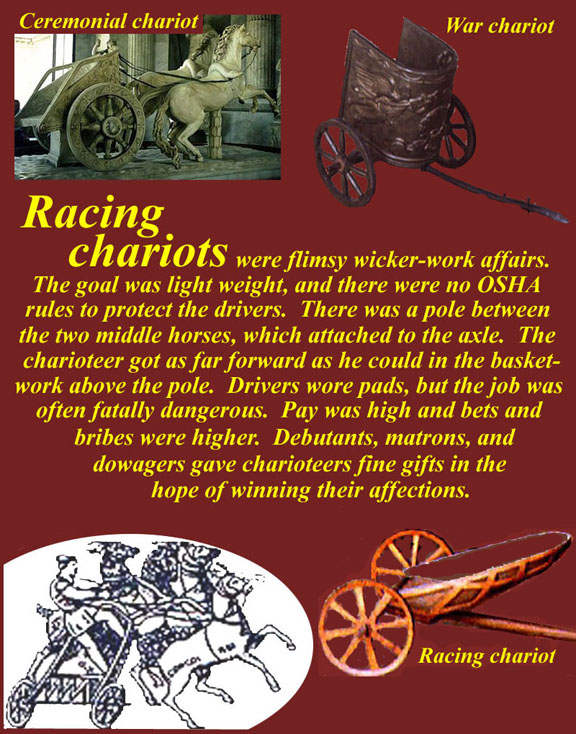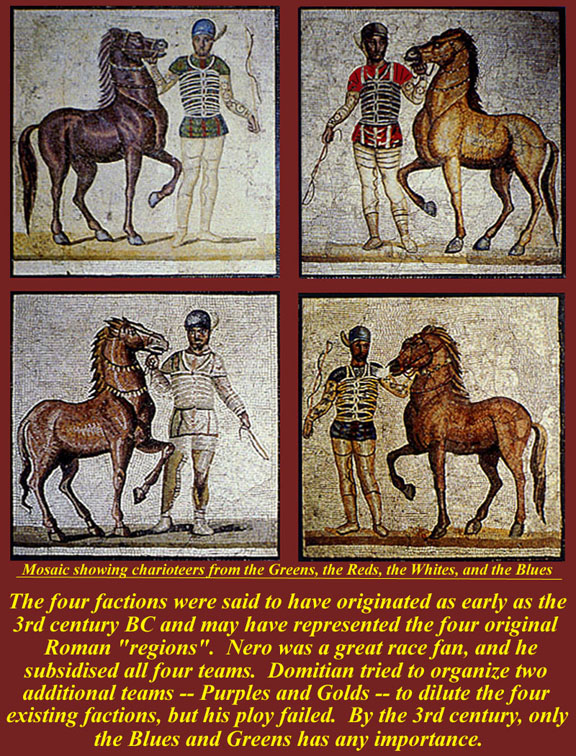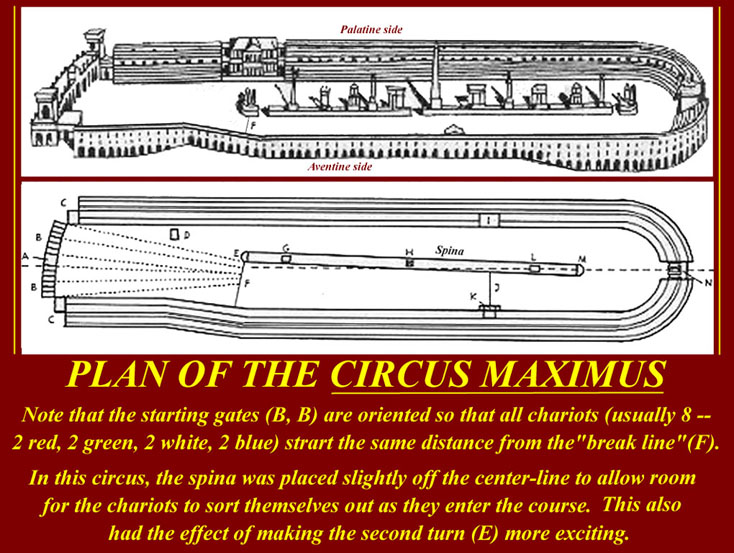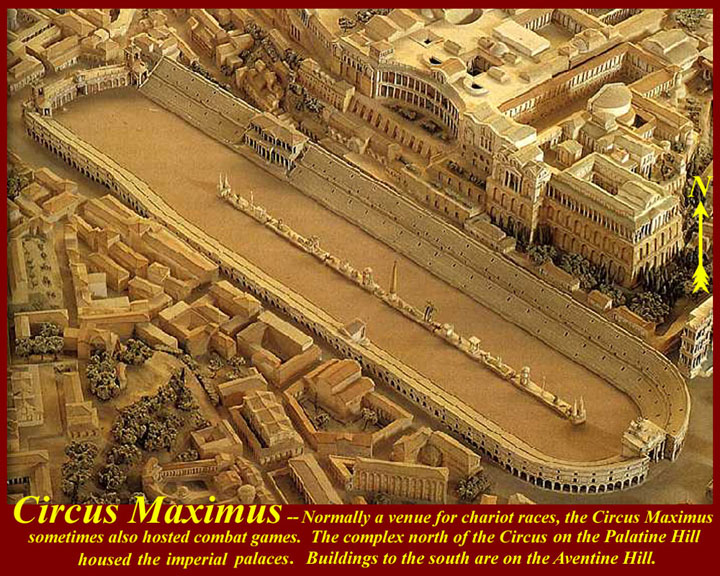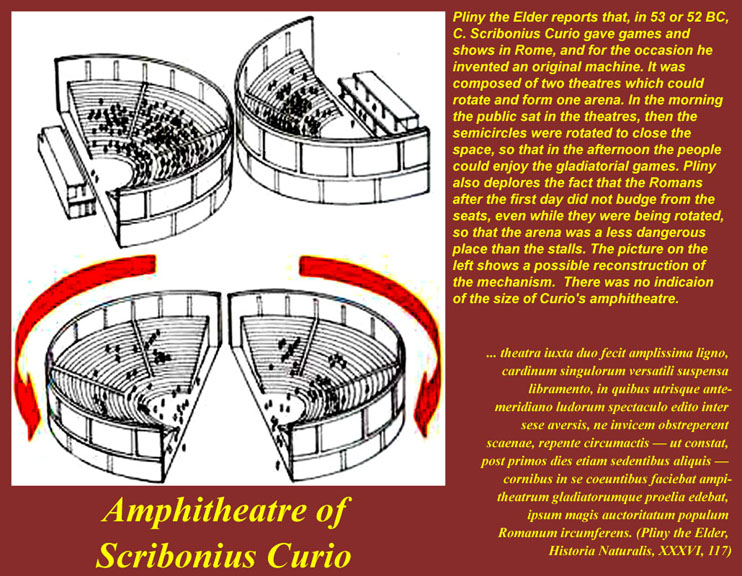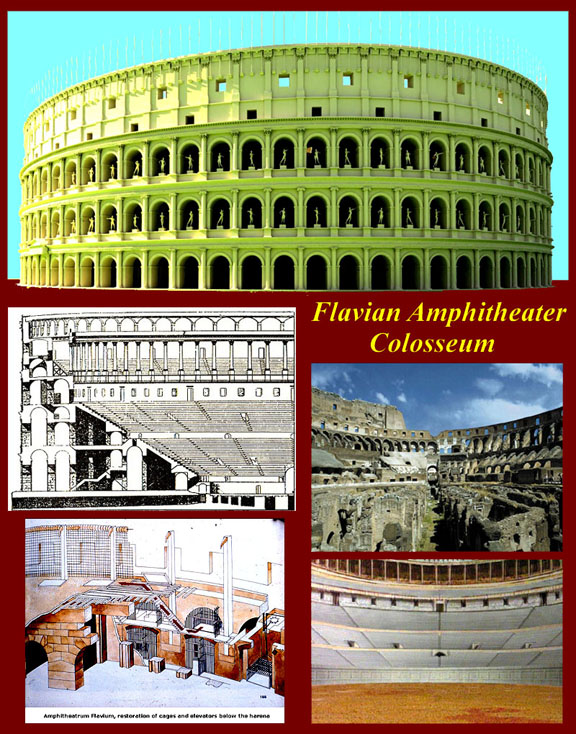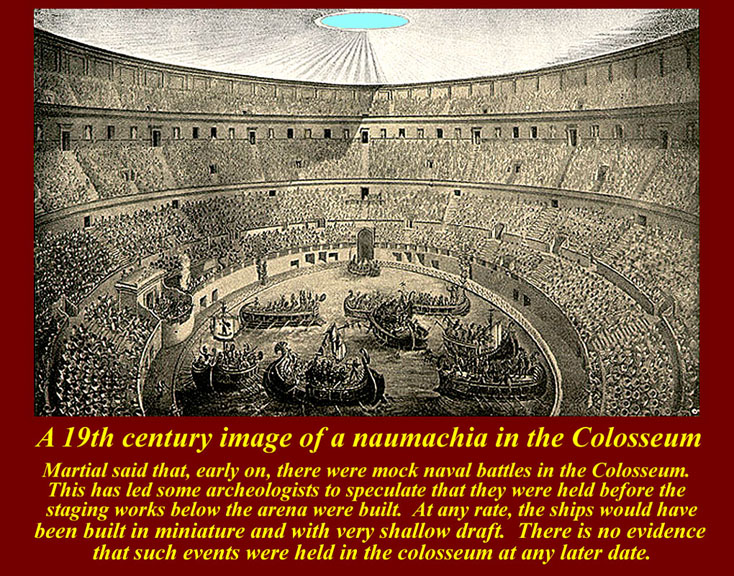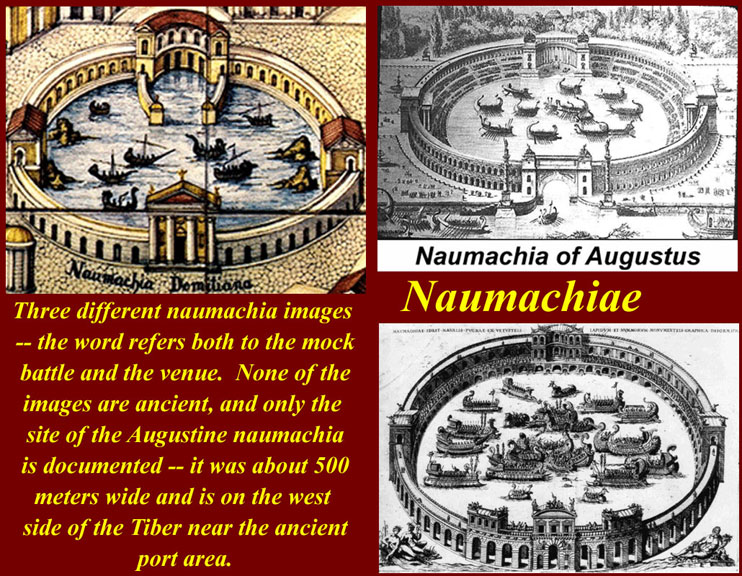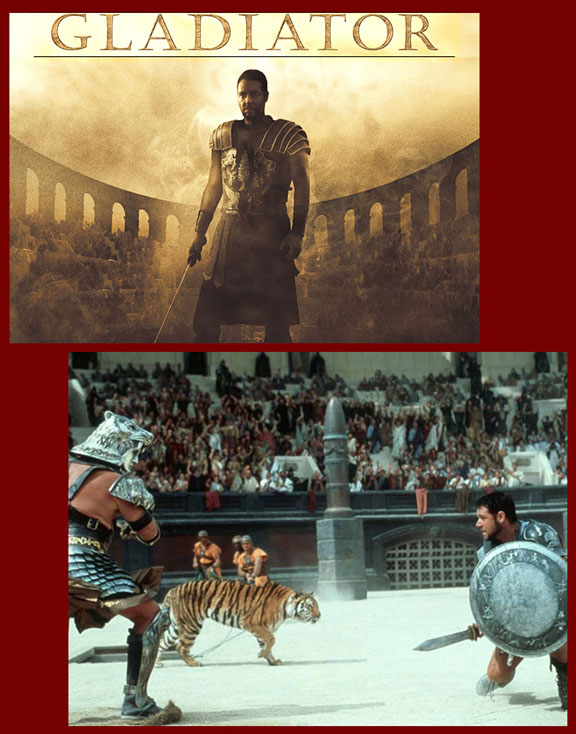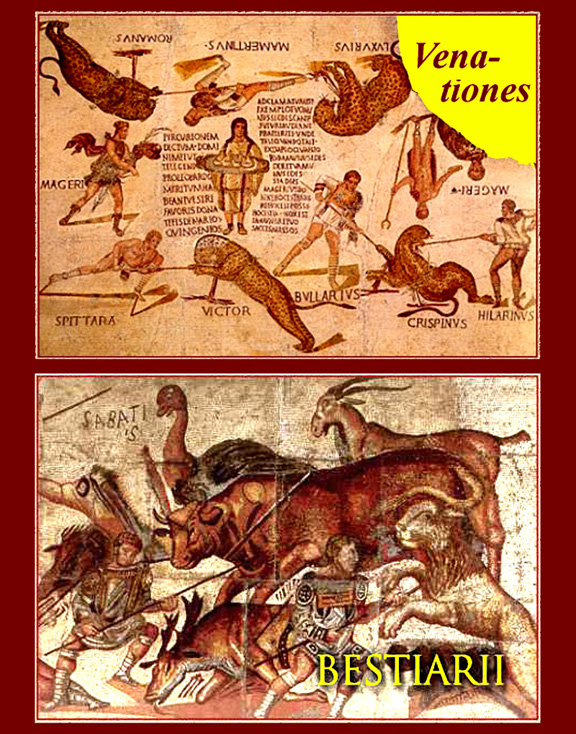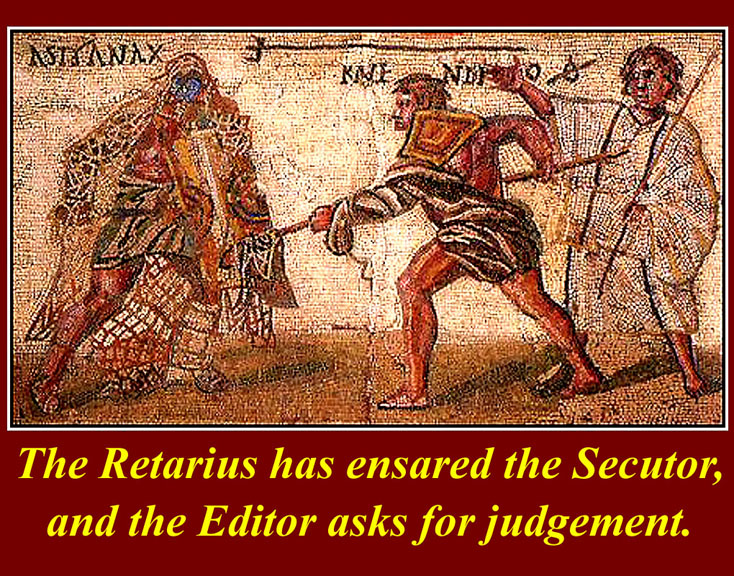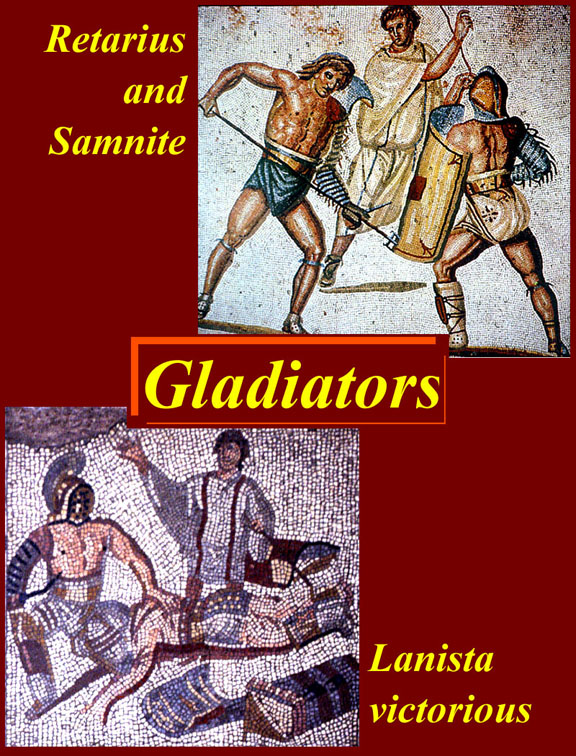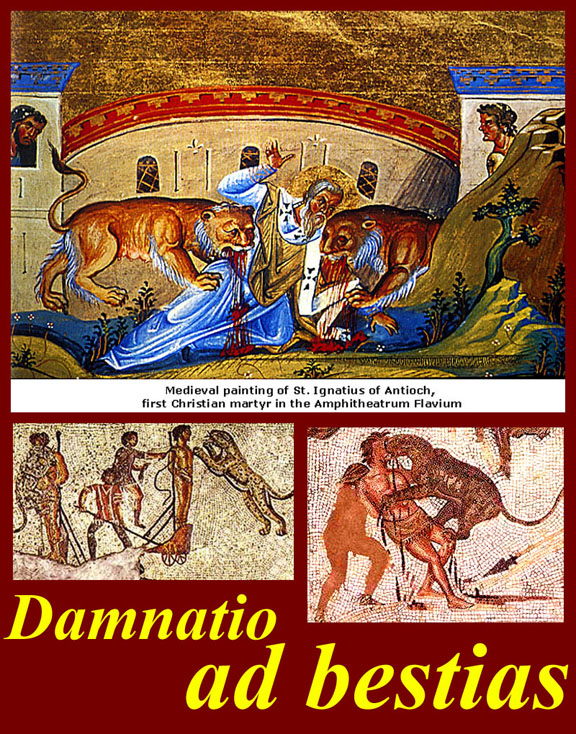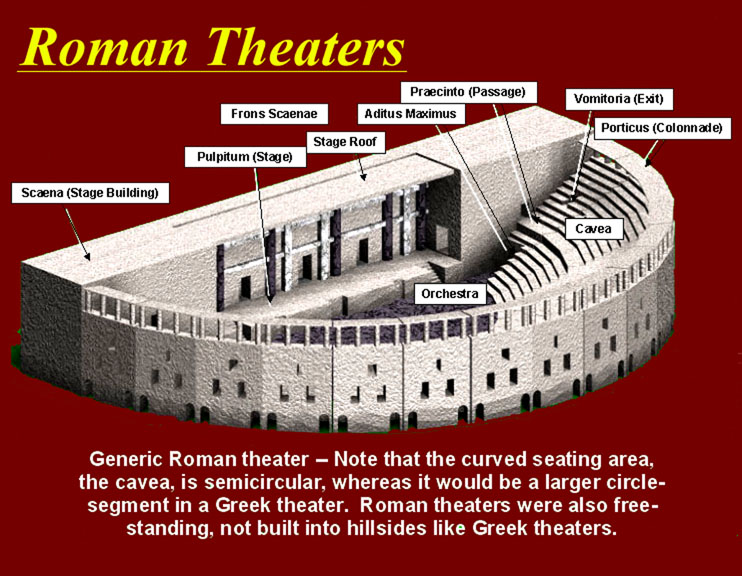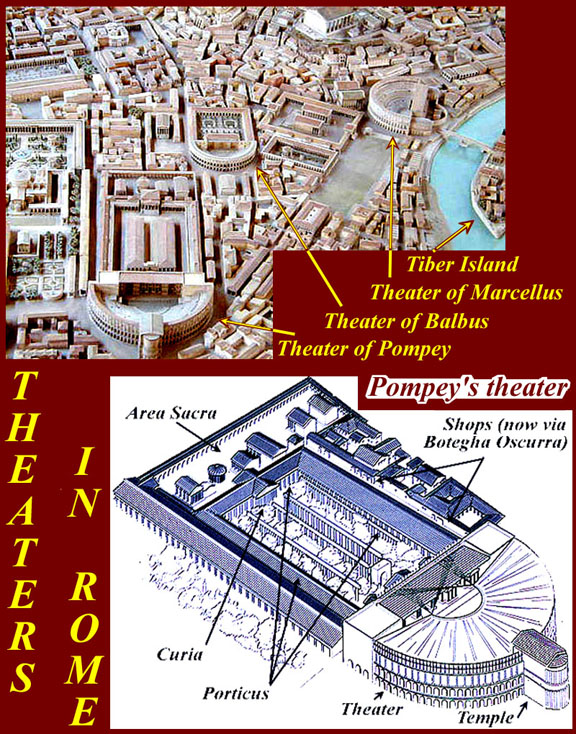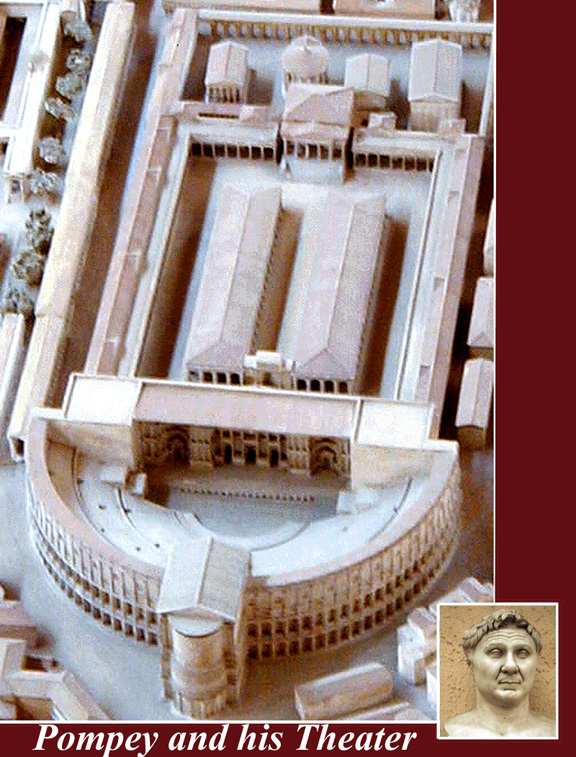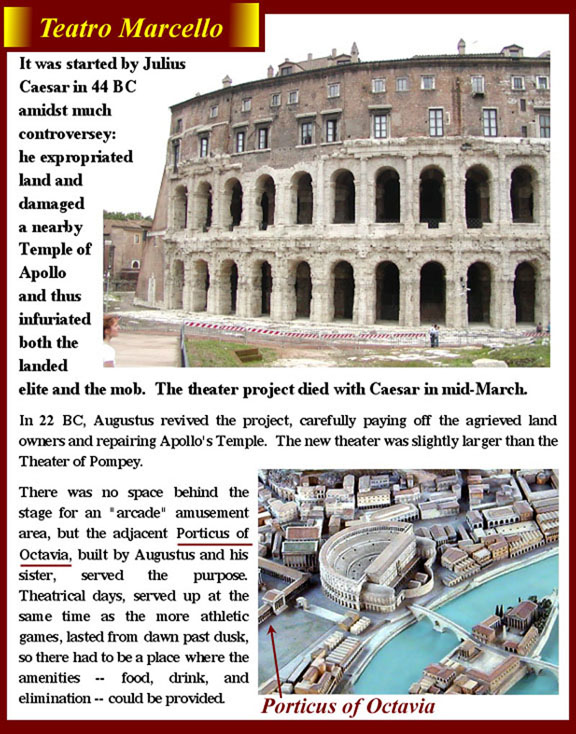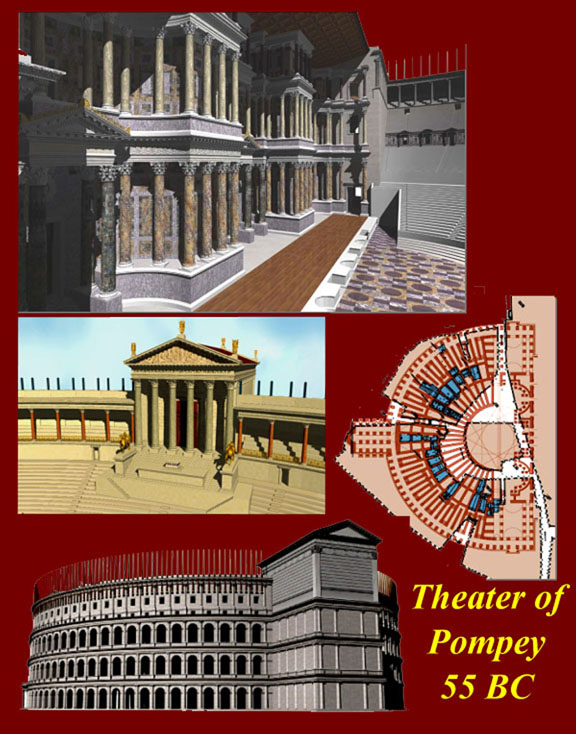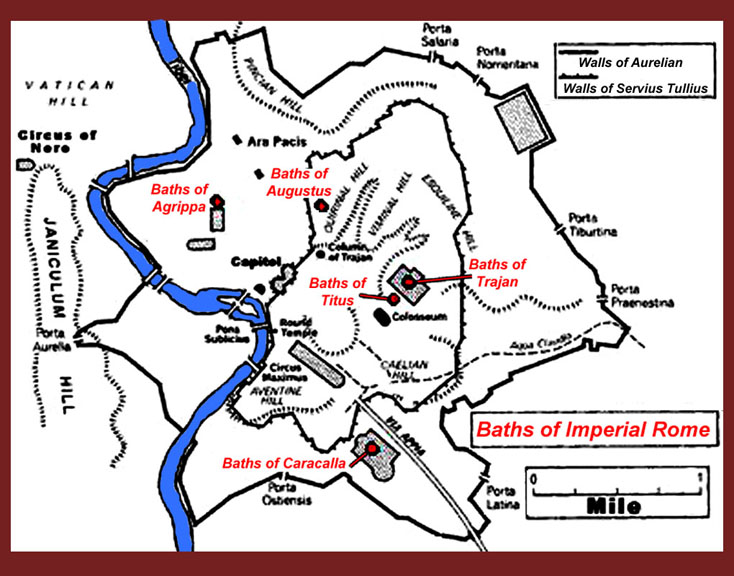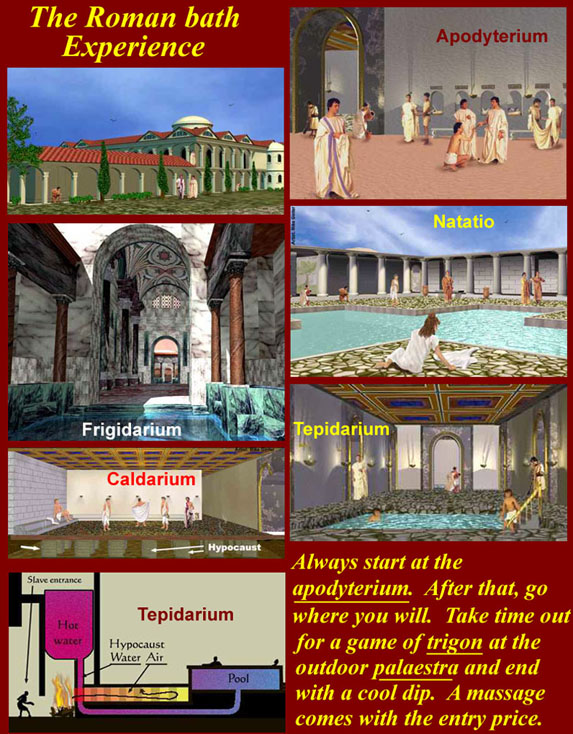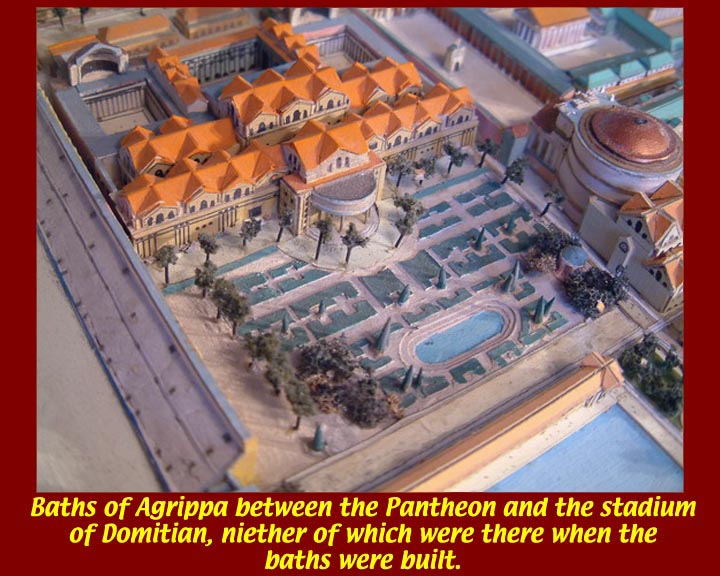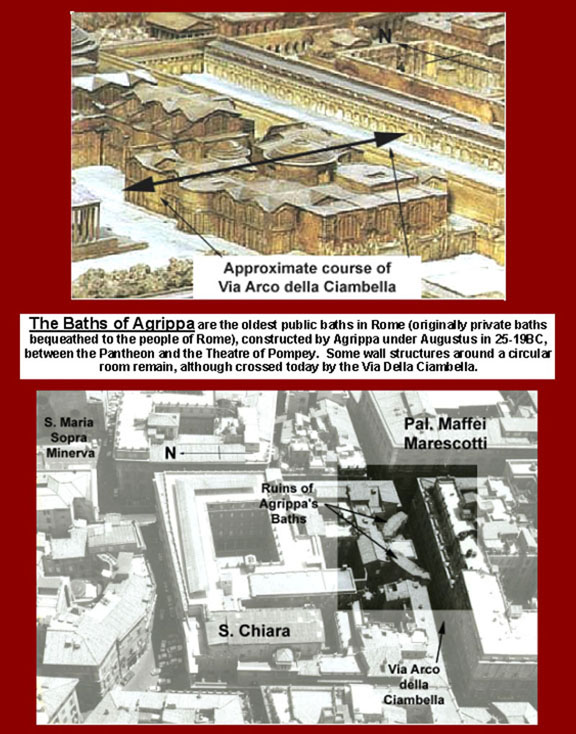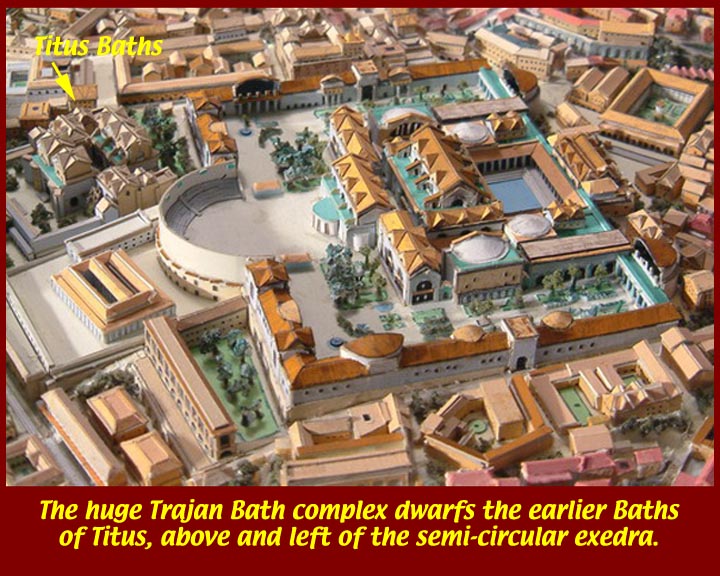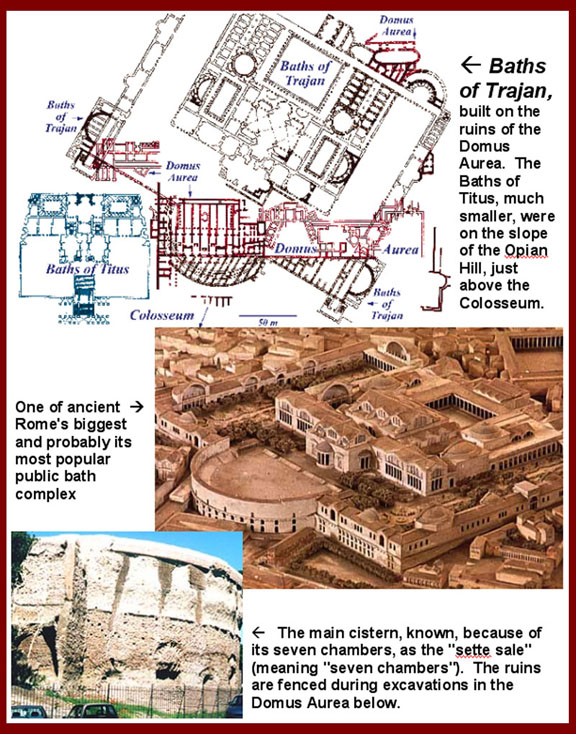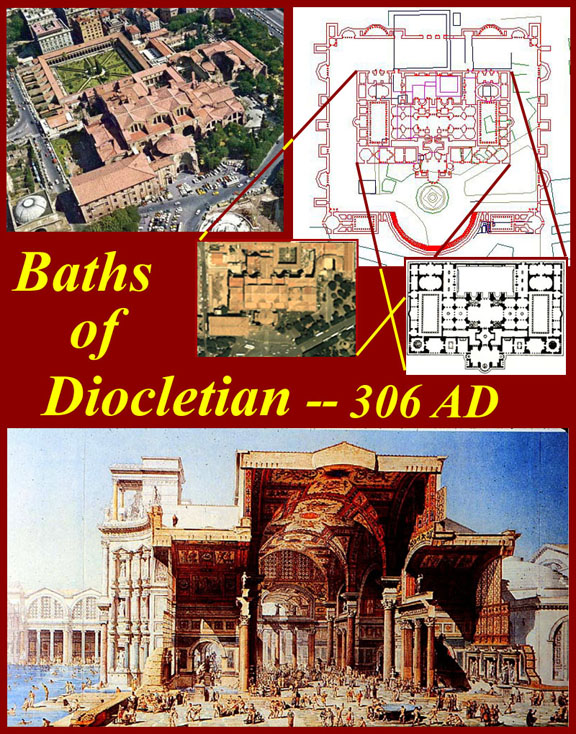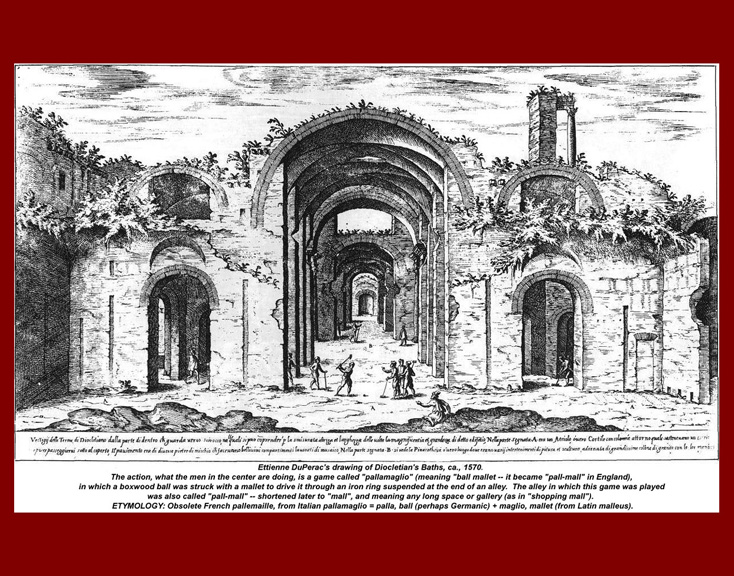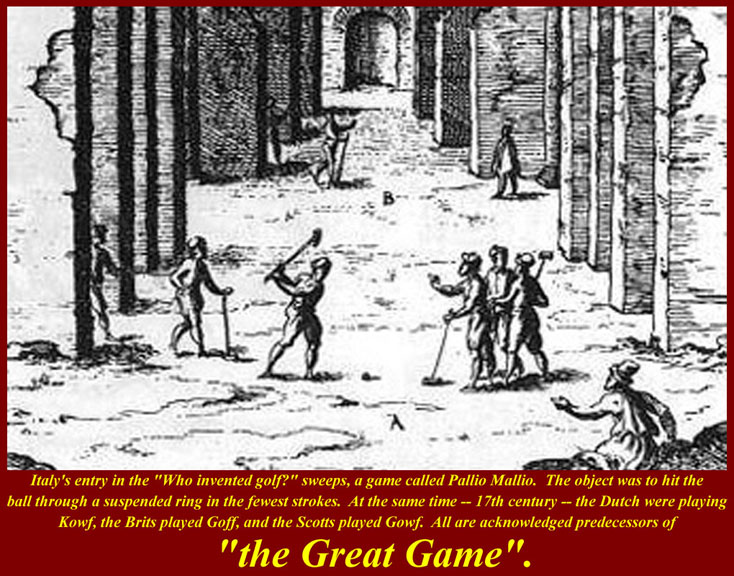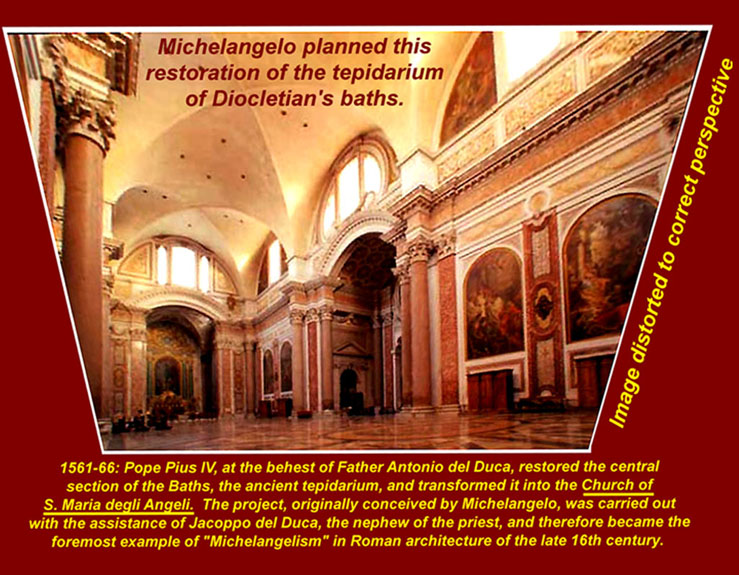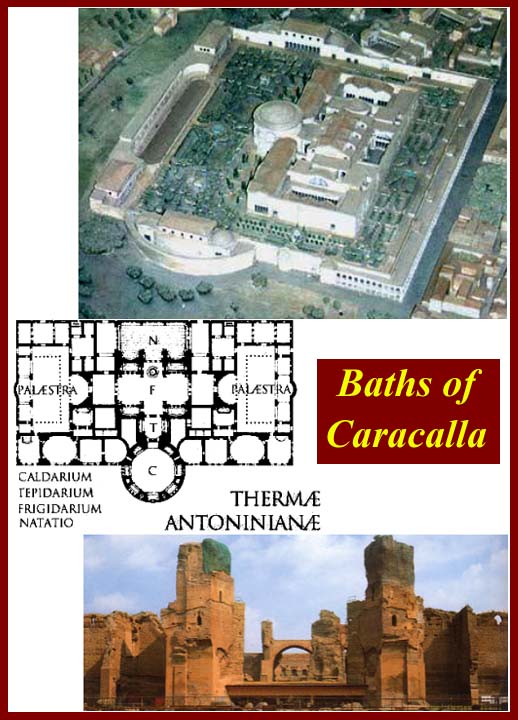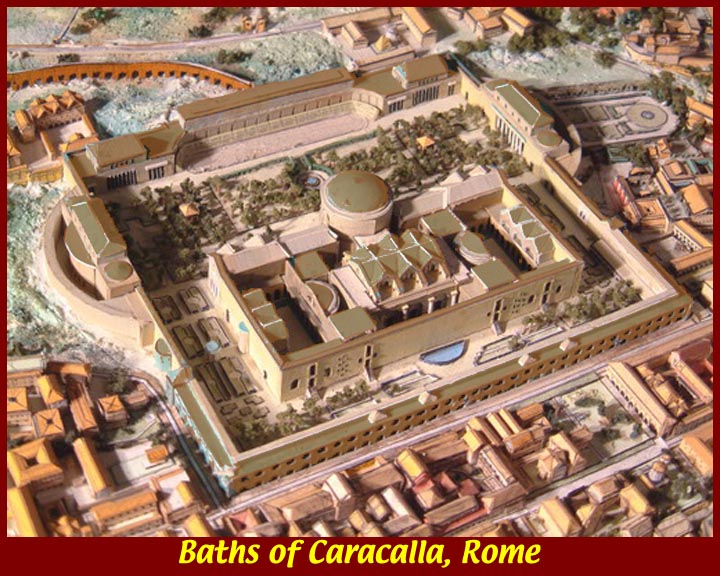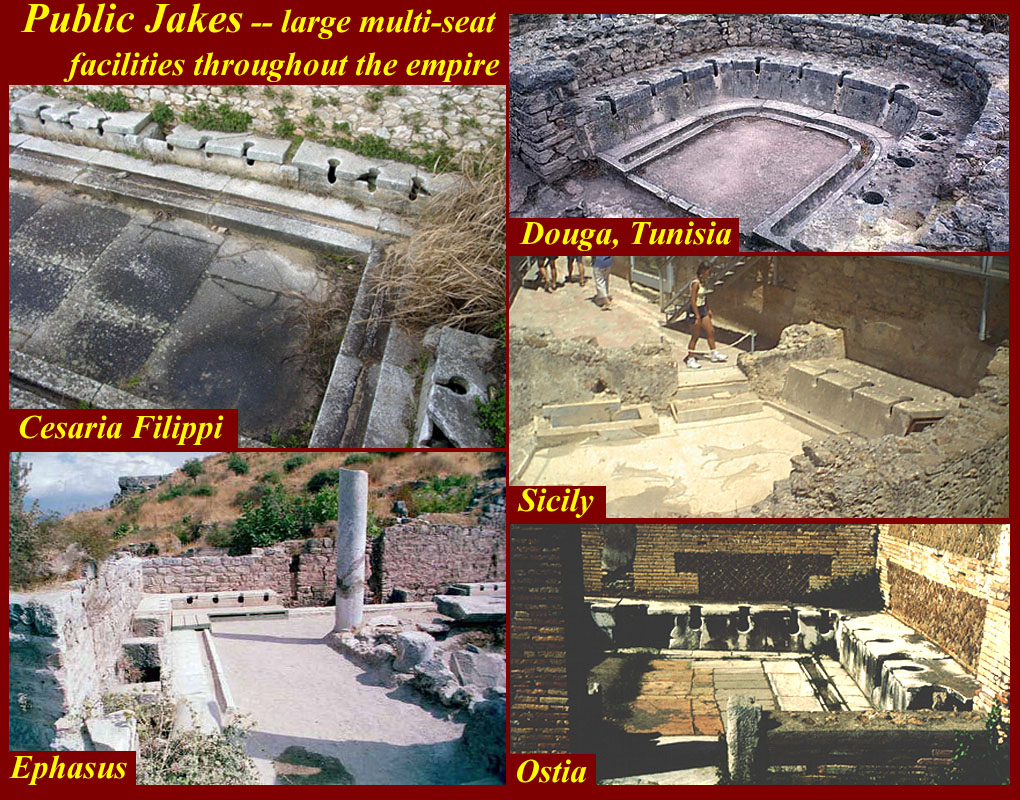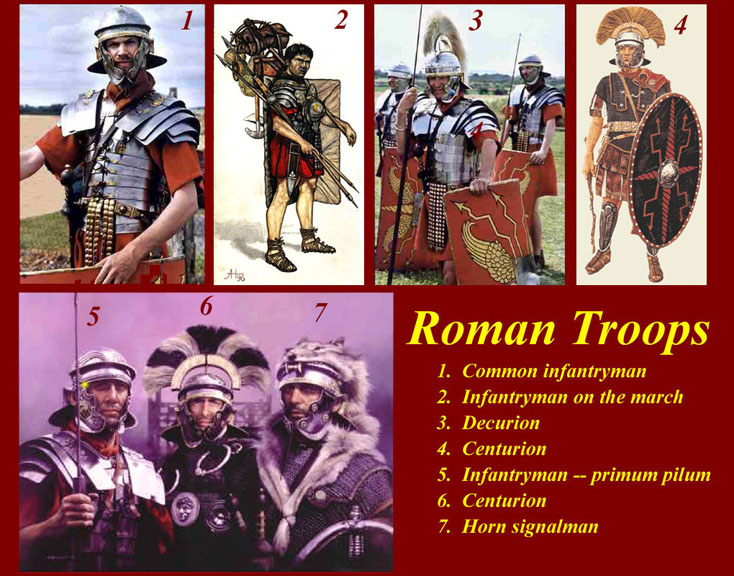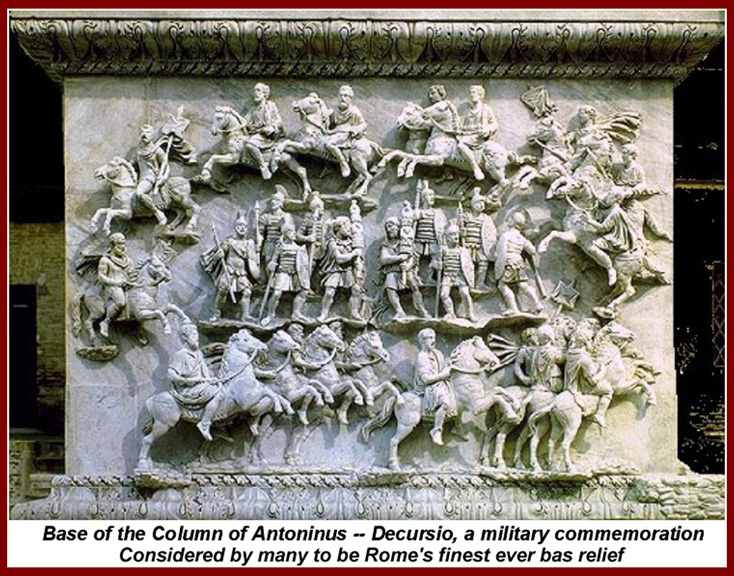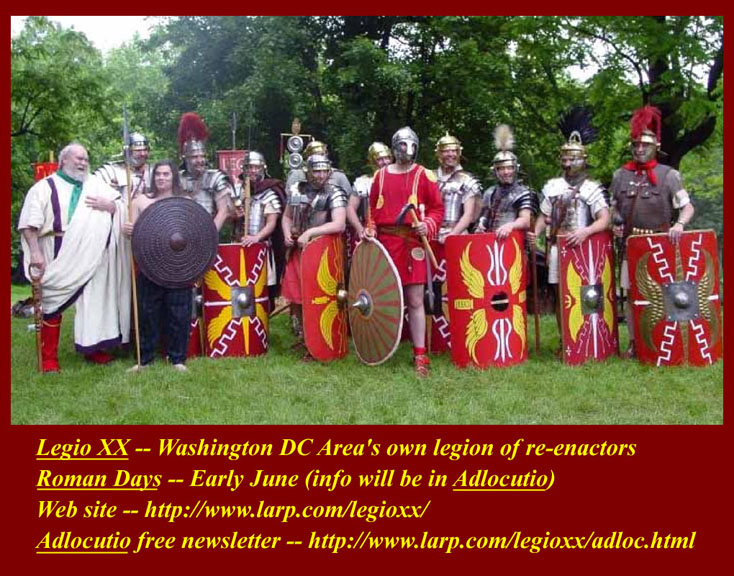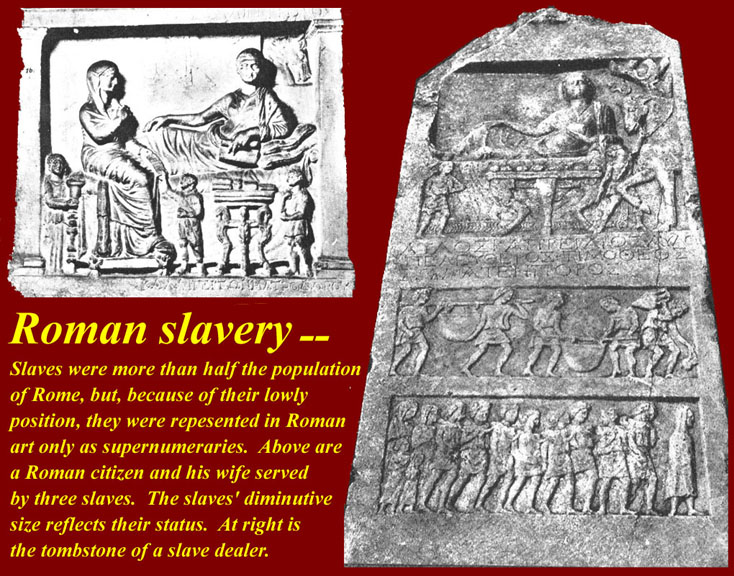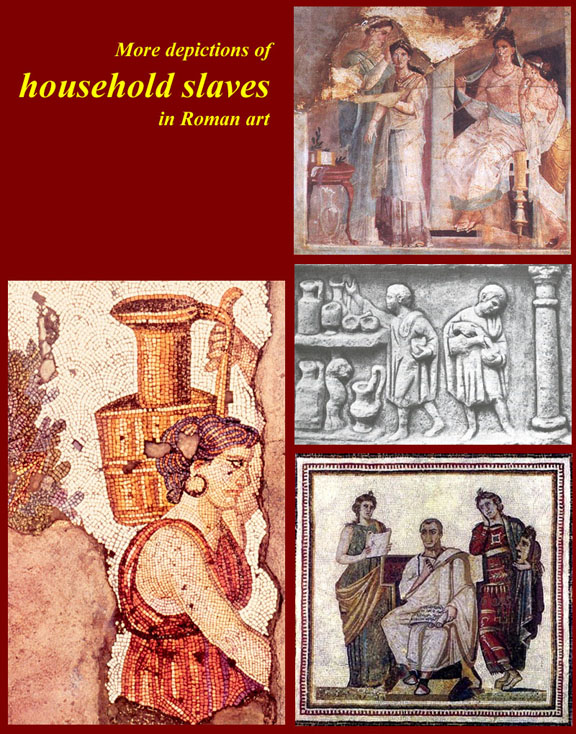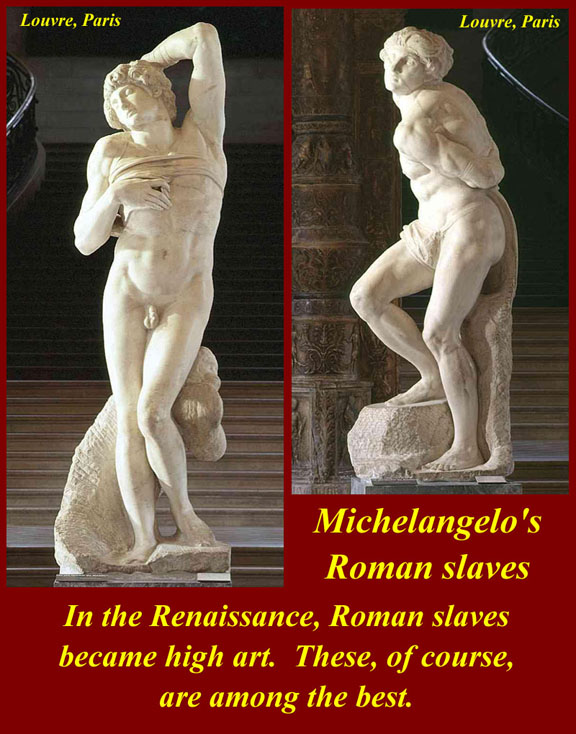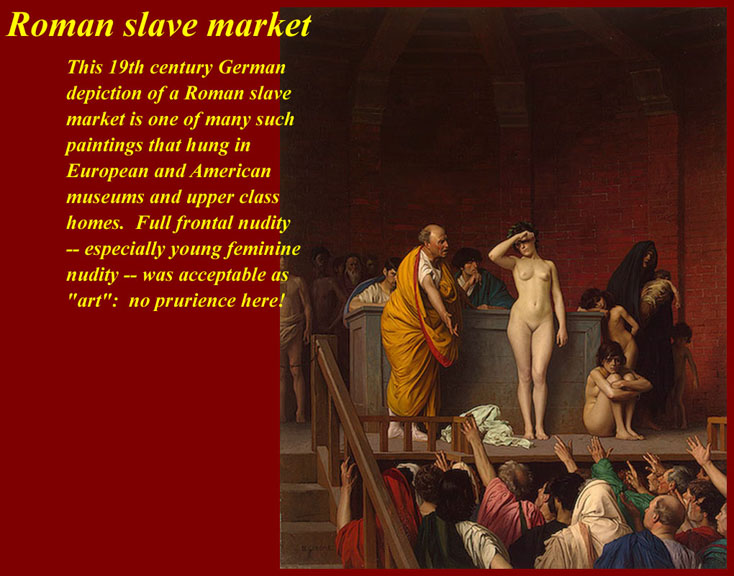Ancient Rome
Unit 9 Rome Daily Life
Click on links or small images below to see larger versions of the images.
http://www.mmdtkw.org/00-01DailyLifeSplash.jpg
A view of the full developed "Republican" Forum. Probably nothing in this image dates from the Republican period -- everything has benefited from later urban renewal. For centuries the Forum was the social, religious, legal, and commercial gathering point for Rome. Like the baths, which were less formal, it was where an active citizen went to see and to be seen. Starting with Julius Caesar, several Emperors built additions to the forum (known collectively as the Imperial Forums), and the locus of some activities shifted within the forum landscape. The Roman forum started as a consumer marketplace, but such activities gradually were pushed out into the riverside port area, where the forum boarium and forum holitarium were located. The wholesale market shifted down river to the emporium.
http://www.mmdtkw.org/00-02Map100AD.jpg
Roman Empire in 100 AD: A map showing the Roman Empire at its largest. "Daily life", of course, varied by social class, location and time period. We do not live the way our ancestors lived in the 10th century, so we could not expect ancient Rome's lifestyle to be static over its over its history of more than 1000 years. But the Romans had a greater respect for the past than we do, so practices and institutions did last longer.
--------------------------------------
Family
http://www.mmdtkw.org/01-01AncestorReverence.jpg
Ancestor Reverence: Rome had its great temples for the great gods, most of whom were imported and many of whom just faded away. But throughout Roman history, even when the great gods were being eclipsed by foreign mystery religions, the home gods, who were anchored by the dead ancestors, the underworld di manes, stayed stable. Death masks (called imagines) of ancestors, especially those who may have somehow distinguished themselves and the name of the family, were kept in special cabinets in the entrance foyer of the home to be displayed when guests arrived. The same masks, often made of lifelike colored wax, were worn in ceremonial and funeral parades. Graves and tombs bore portrait images of the dead, and on special occasions and death anniversaries, meals were served at graveside, food was left for the dead, and wine was poured directly into the grave through specially designed openings.
http://www.mmdtkw.org/01-02TableOfRelationships.jpg
Table of Relationships: One of the reasons Roman family relationships are hard to fathom is that they, like many modern Latin societies, used the same terms to describe several different kinds of relationship. In the chart above, you will see that several younger relatives can be designated as <nepos (m.) > or <neptis (f)> which is usually translated as nephew of niece. Uncles and aunts are similarly multiple. This was made even more complicated by the tradition of adult male adoption, although at least in those cases naming conventions could give clues: any name that included a agnomen with "-anus" as a suffux indicated that the person so named had been adopted from the gens indicated by the front end (Octavianus was adopted from the Octavius gens) -- unless, of course, the front end was a place (Africanus had conquered Africa but was not adopted from a hypothetical Africus gens).
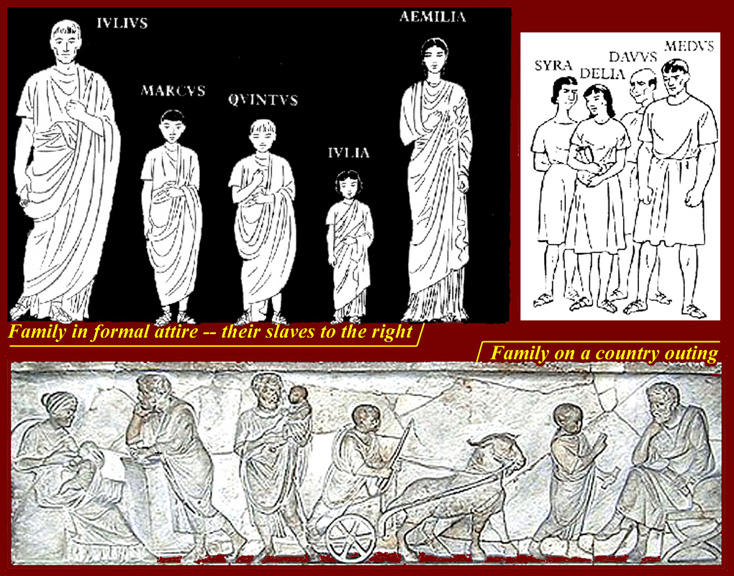
http://www.mmdtkw.org/01-03FamiliaRomana1.jpg
http://www.mmdtkw.org/01-04BirthingNursing.jpg
Roman Family: a "familia" was headed by a "paterfamilias", who legally could do anything he wanted with any other member of the family -- give them in marriage, put them out for adoption, sell them into slavery, beat them, or even kill them. He was expected, however, to treat them well, educate them (even girls), and be a good father. It's worth noting, however that the oldest surviving male would be the paterfamilias; if a father died, his eldest son would be the paterfamilias of his mother and older sisters.
Newborn children were not considered persons until they had been accepted by the father. They were placed at his feet, and, if he rejected the child, it was abandoned to the elements -- at least in theory.
All dependents of the paterfamilias were considered part of the family, and this included all slaves of all family members.
Family and personal scenes were often depicted in art, usually to show how a good family functioned and the kind of care that family members should expect.
----------------------------------
Home
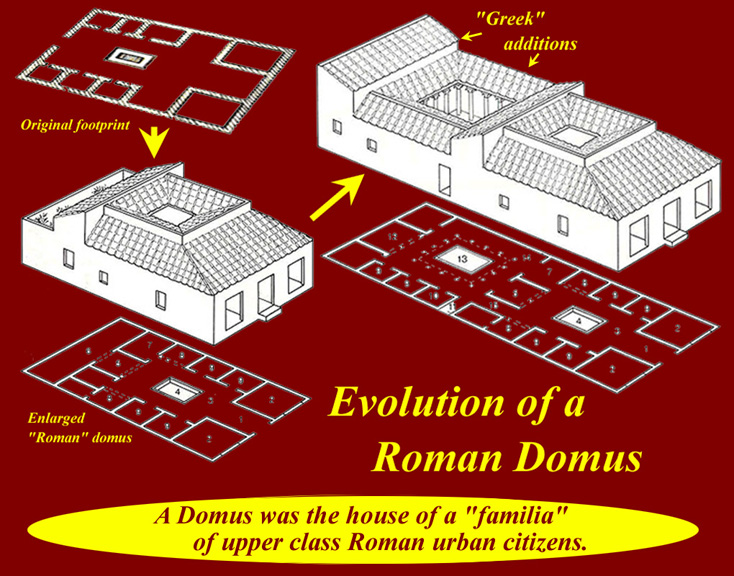
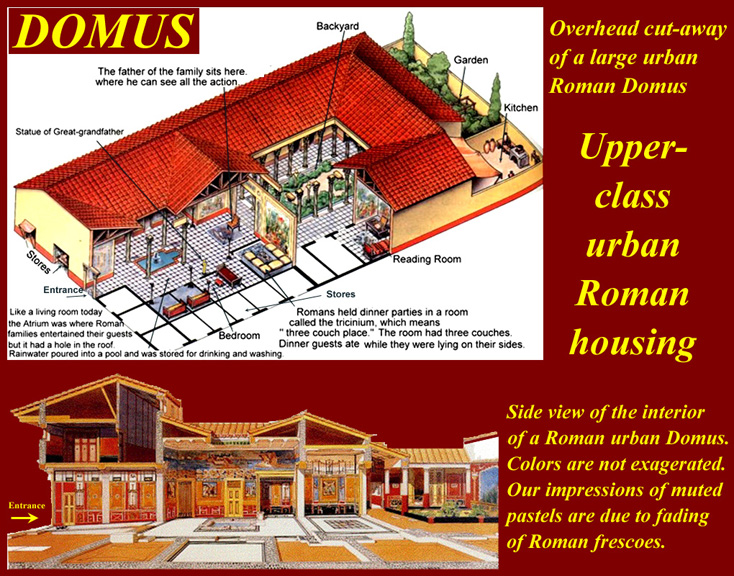
http://www.mmdtkw.org/02-01-01DomusEvolves.jpg
http://www.mmdtkw.org/02-01-02Romanhouse.jpg
http://www.mmdtkw.org/02-01-03DomFlavia.jpg
City residences -- Evolution of the Domus: Every Roman citizen and freedman aspired to own a domus. The "Roman" domus was really just a variant of an earlier Latin atrium house, but the Romans were reluctant to credit anyone else with their primacy of the design. The urban domus design had much ha much in common with the agricultural and the suburban villa although the latter two often had additional work spaces (see below). There was no real limit to the size to which a domus or villa could grow.
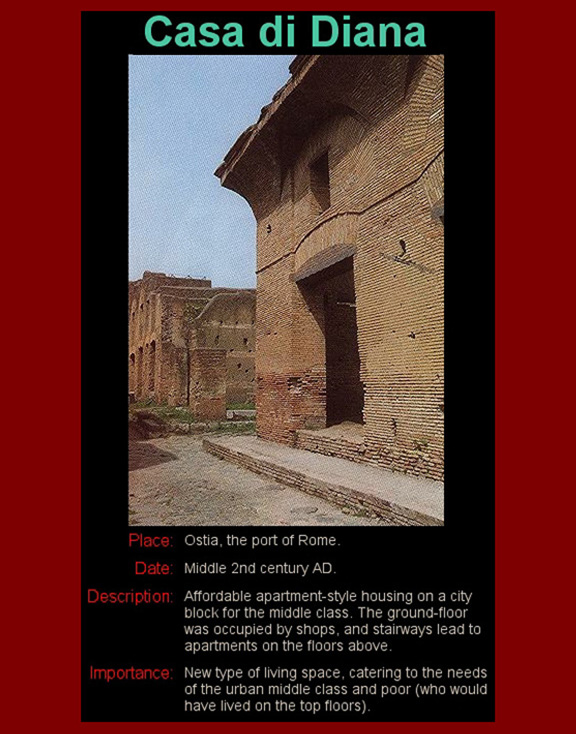
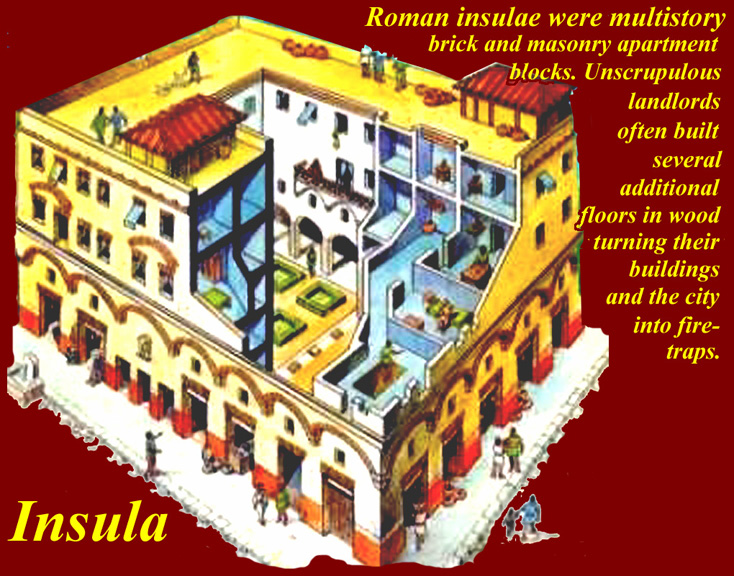
http://www.mmdtkw.org/02-02-01CasaDiDianaOstiaIn.jpg
http://www.mmdtkw.org/02-02-02insula1.jpg
http://www.mmdtkw.org/02-02-03OstiaInsulaOfSerap.jpg
City Residences, the Insula -- Casa di Diana in Ostia, notional insula, and Insula of Serapis and the Charioteers in Ostia: Although everyone wanted to own a domus, almost all denizens of Rome lived in large apartment-houses, which were called insulae. (The apartment-house insula shouldn't be confused with what archeologists called an insula in the cities buried by Vesuvius in 79 AD. The archeologists' insula was simply any city block of buildings although it is usually centered around one or more domus type structures.) The insula shown in the third image above was very posh, and, therefore, it is thought to have been an apartment hotel for rich merchants visiting or keeping temporary residences near the Ostia port.
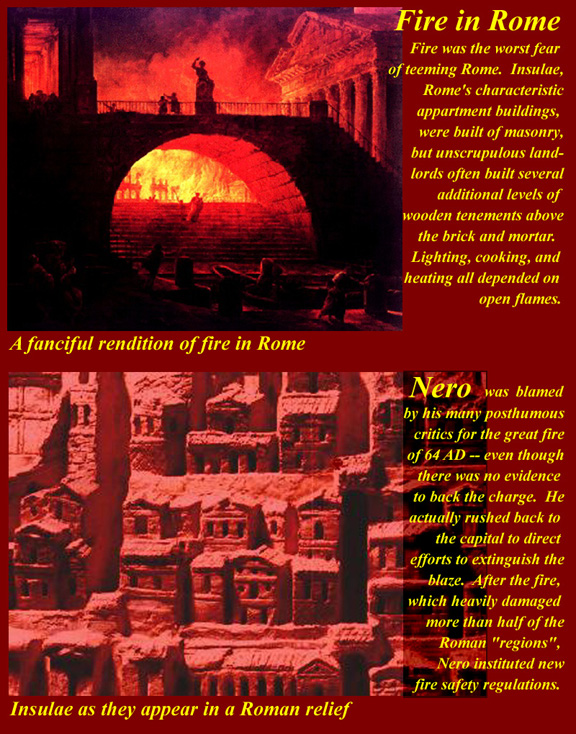
http://www.mmdtkw.org/02-03-01RomeFireInsulae.jpg
http://www.mmdtkw.org/02-03-02VigilesRomani.jpg
Protecting Roman residences: Vigiles, Roman firemen and equipment: All Roman cities and especially Rome itself were always in danger of fire. Although lower floors of houses and apartment buildings were almost always made of masonry, there were often wooden superstructures. Whole neighborhoods of appartment buildings might have five or six floors of shoddy wood-built apartments built on top of two or three masonry levels. The Suburra neighborhood in the valley between the Viminale and Esquiline Hills was particularly apt to spawn fires that would then spread to other parts of the city -- that's why the buildings in the Imperial Forums were separated from the Suburra by fireproof walls made of fireproof volcanic stone called peperino.
Rome had well equipped fire brigades, who were part of the vigiles corps that also included more generalized night watchmen. Roman fire pumps were very effective, and their high pressure bronze swivel nozzles were almost exactly the same design as those still used today. Fire houses were spotted around the city. Eventually other cities in the empire were similarly equipped. After the great fire of 64 AD, Nero greatly increased the size of the vigiles corps, increased their equipment budget, and mandated fire escapes and fire-fighting platforms built onto the outside of high buildings. These measures did not prevent all future major fires, but they probably extinguished some before they could spread.
A list of Rome's major fires is at http://sights.seindal.dk/sight/1184_Fires_of_Rome.html.
For an English translation of Rudolfo Lanciani's chapter on Rome's vigiles from his masterful 1888 Ancient Rome in the Light of Recent Discoveries see http://penelope.uchicago.edu/Thayer/E/Gazetteer/Places/Europe/Italy/Lazio/Roma/Rome/_Texts/Lanciani/LANARD/8*.html.
For the translation of the whole of this Lanciani book, go to http://penelope.uchicago.edu/Thayer/E/Gazetteer/Places/Europe/Italy/Lazio/Roma/Rome/_Texts/Lanciani/LANARD/home.html.
http://www.mmdtkw.org/02-04-01Villa_Rustica-a.jpg
Villa Rustica -- the "rustic" villa would be a simple farm house in which a farmer or tenant would live with his family and often with his animals.
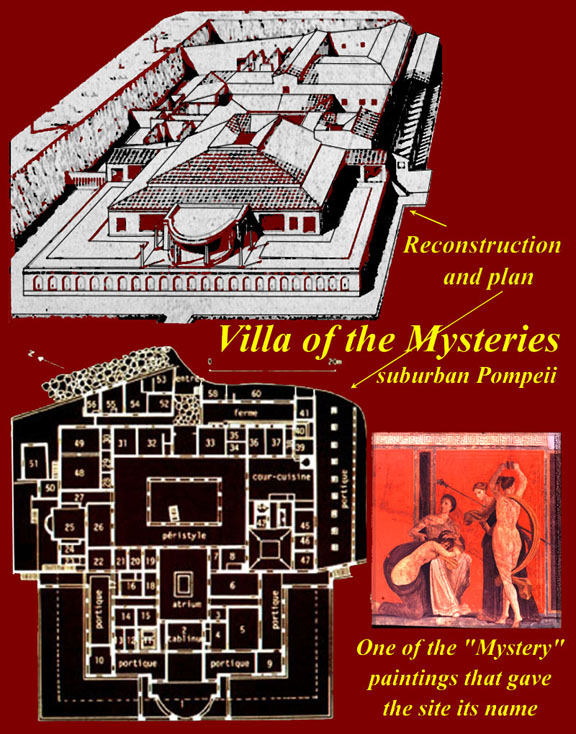
http://www.mmdtkw.org/02-04-02VillaMystSlide.jpg
http://www.mmdtkw.org/02-04-03hadrian_villa.jpg
Lifestyles of the Rich and Famous -- Villa of the Mysteries in Pompeii and Hadrian's Villa in Tivoli/Tiburtina: The Villa of the Mysteries, so named by 19th century archeologists after frescoes of the Dionysian Mysteries were found inside, was one of many "suburban villas" that were buried int eh 79 AD Vesuvius eruption. It stood a few hundred meters outside the gate of Pompeii that faced toward Vesuvius, so it was buried first by the ash fall and then by one of the pyroclastic flows that followed. Large parts of the villa are well preserved, although all of the roofs that now cover parts of the structure were added by the archeologists to protect what remains. The core of the villa was a domus style structure, but several stages of expansion made it into a very large villa with gardens, a set of baths, large public rooms, and even its own large scale winery. There are numerous Internet sites and books on this villa. Use your web browser to find them: search for villa mysteries.
Emperor Hadrian's villa in Tiburtina (modern Tivoli) is the largest villa complex that has been discovered. It is distinguished by structures in architectural styles that Hadrian saw on his travels and copied in full scale. The complex has two large theaters, one each of Greek and Roman style, large pools, water gardens, and residential and work areas. Recent excavations (2007-08) have exposed more structures south (top) of those shown in the model and plan in the second image above. Hadrian built most of the villa in the early part of his reign, but probably never really lived there. He spent most of his time on extensive travels around the empire (which was at its largest during his reign) and died in a different large villa that he had build near the northern end of the bay of Naples. There are also many Internet sites for this villa. Search for hadrian villa or villa adriana.
------------------------------------
http://www.mmdtkw.org/02-04-04LaterRomanVillas.jpg
Later Roman Villas: the large Roman exurban was copied, with local variations, throughout the Roman Empire and beyond.
Food
The three great agricultural staples were olive oil, wheat, and grapes.
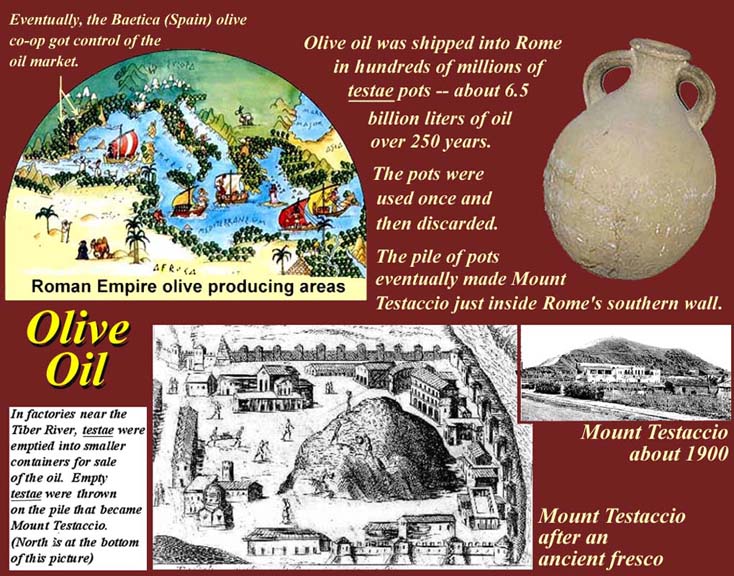
http://www.mmdtkw.org/03-01OliveOilMarketing.JPG
http://www.mmdtkw.org/03-02AncientModernOliveOil.jpg
Olive Marketing, Ancient/modern olive oil production: Most of Ancient Rome's olive oil came from Baetica in Spain. (It still does, and Italy today still consumes more than 30 percent of the world's olive oil trade, more than any other country). The Baetica Spanish olive growers then as now pretty much controlled the world olive oil market -- they now produce a bit more than 35 percent of the world's olive oil.
As the Ancient Roman demand for olive oil increased, special shipping methods came into use -- large purpose made jars called testae and then purpose built ships to carry the jars. A whole industry sprung up along the Tiber at Rome's southern edge just to rebottle the oil for sale in the city. Over the hundreds of years of ancient Rome's existence, a "mountain" of millions of large used oil jars accumulated, Monte Testaccio -- the jars couldn't be : too expensive to ship back, and residual oil would go rancid and spoil any new oil put in a reused jar. For information on the world olive oil trade, see http://en.wikipedia.org/wiki/Olive_oil.
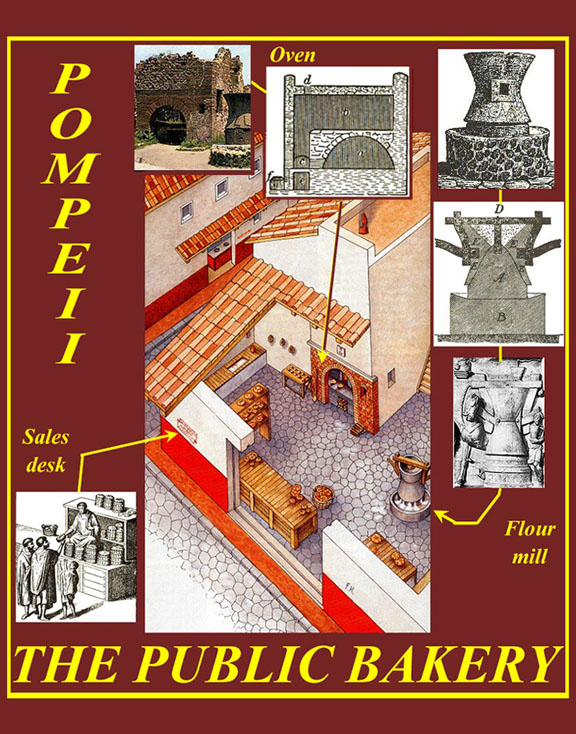
http://www.mmdtkw.org/03-03Bakery.jpg
http://www.mmdtkw.org/03-04BarbegalMill.jpg
Roman bakery, Barbegal multi-mill: Most Romans were eligible for a daily dole of imported grain. They would take the grain to their local bakery and hand it over to the baker with a few coins and immediately take home fresh hot bread. Several grades of bread were available, and what you got was determined by what you paid the baker, because the small payment was for his work rather than for the bread.
A Roman bakery and its mill was a pistrinum -- the pistrinum was really the mill itself, but the bakery also was called, by association, a pistrinum. A baker was a panifex. In 168 BC, the Collegium Pistorum or Bakers' Guild was established. Baking bread was thereafter seen as a separate profession. Unlike most trades where the workers were slaves, the members of the Collegium Pistorum were freemen. Although choosing to become a member of the Collegium meant that you would be a baker for the remainder of your life.
A requirement of the Collegium Pistorum stated that members were forbidden to mix with 'comedians and gladiators'. Bakers were also forbidden to attend performances at the amphitheater.
The excavations at Pompeii have helped archaeologists determine that some pistrina had the capability to produce thousands of loaves in a given day.
What usually was available at the pistrinum:
Libae - Sweet Honey Cakes
Panis Primus - Cheap bread made from coarse grains.
Panis Secundus - Also with coarse grains but more edible.
Panis Rusticus - Country bread made with bran.
Unleavened bread (Matzah) -- yes, there was a market for kosher foods.
In addition to local mills in bakeries, there also were large industrial mills. A drawing of one in Barbegal near Alres in France is shown in the second illustration. A similar mill (but "undershot" rather than "overshot" like the one in Barbegal) was on the Janiculum Hill in Rome, and its location determined the course of the Aurelian walls which were extended up the Janiculum to include the mill. The Janiculum mill was damaged by barbarian invasions but repaired and in use into the medieval period from which point floating mills anchored in the Tiber River took over production until the 19th century.
For a picture of remains of a panificium/pistrinum in Pompeii, go to http://wings.buffalo.edu/AandL/Maecenas/italy_except_rome_and_sicily/pompeii/ac880824.html.
For more information on the Barbegal mill, see http://www.waterhistory.org/histories/barbegal/barbegal.pdf.
The Janiculum mill has only been partially excavated (late 1990s, Oxford University). It lies under the parking lot of the American Academy in Rome and under adjacent buildings and streets. See http://users.ox.ac.uk/~corp0057/JaniculumMills.html and successive page.
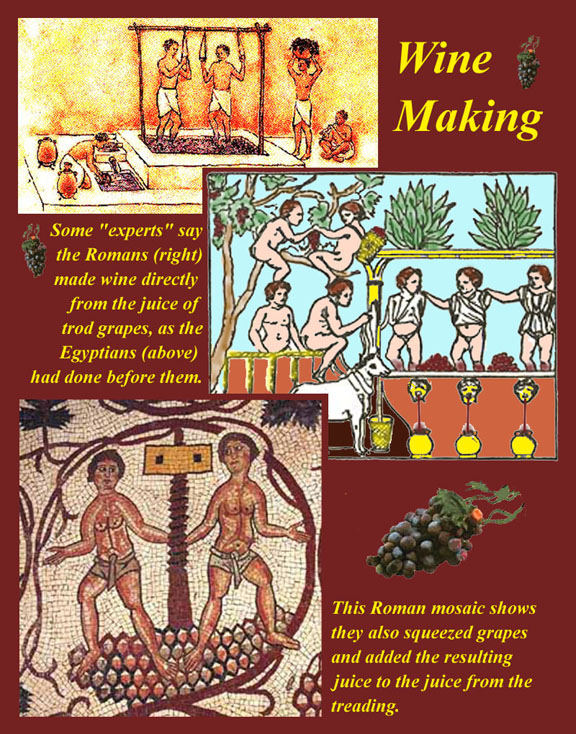
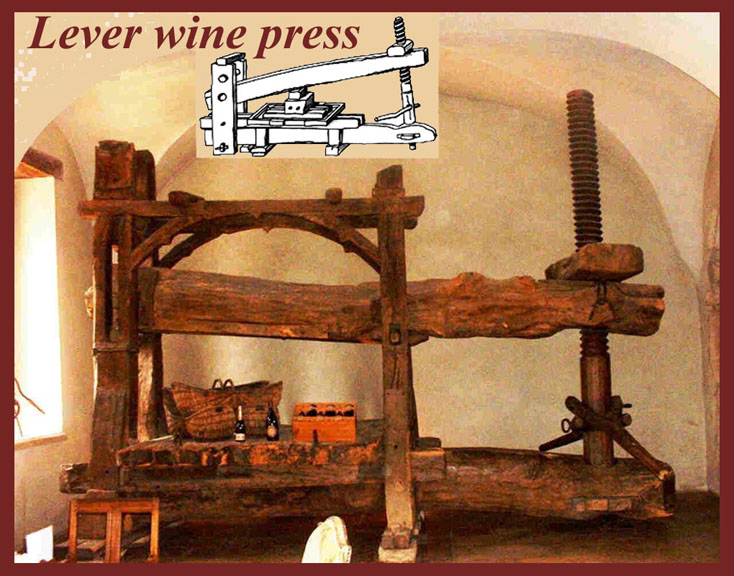
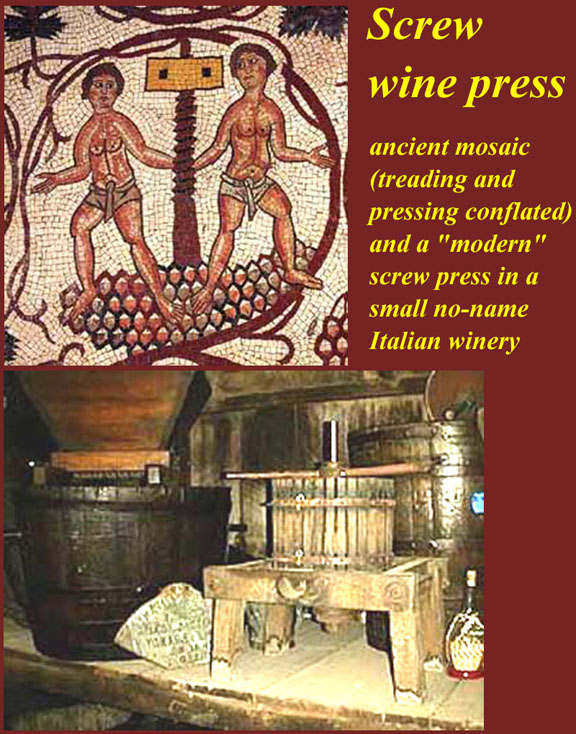
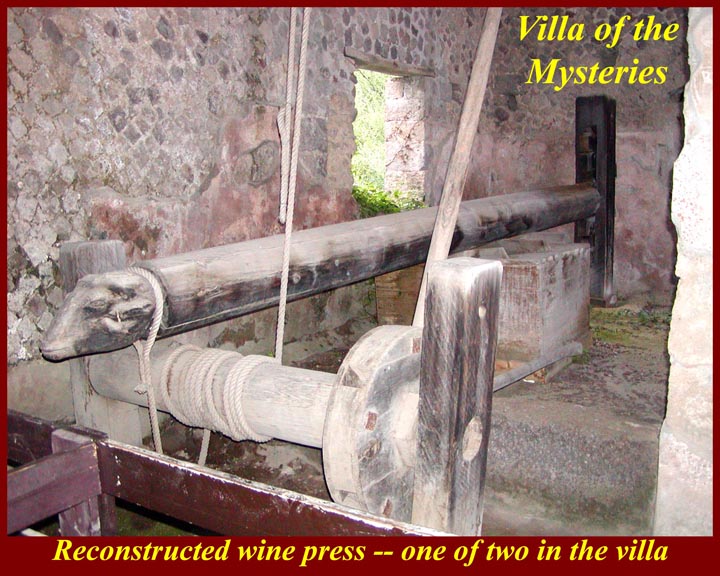
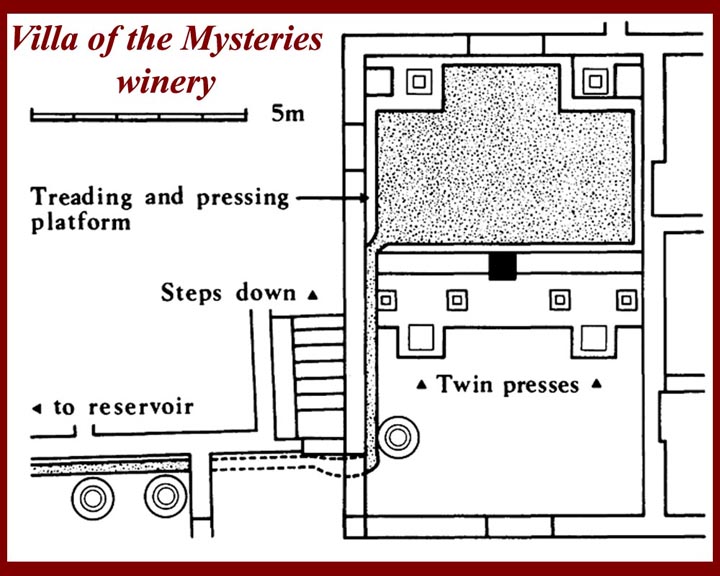
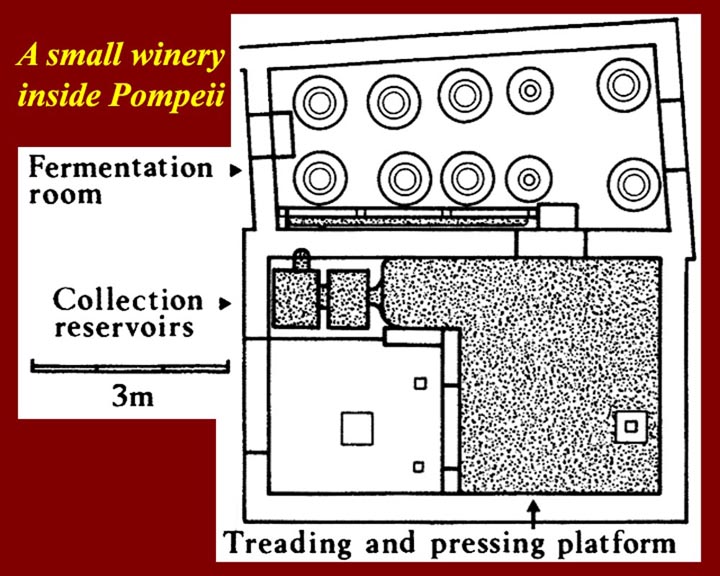
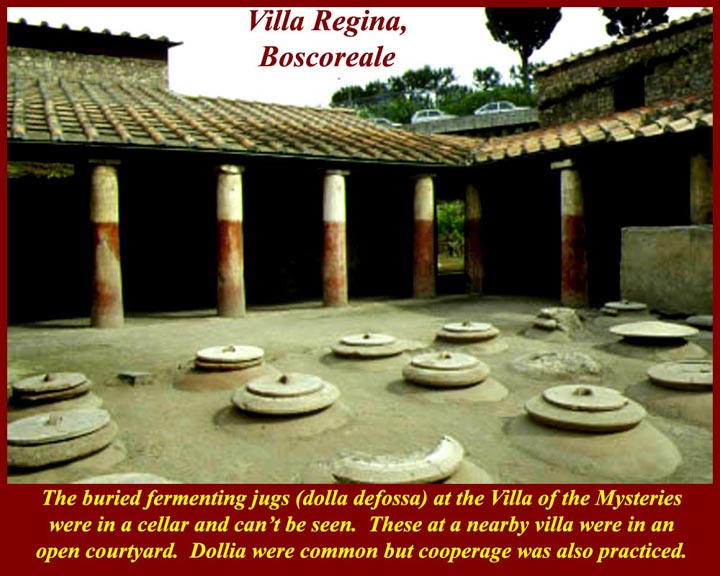
http://www.mmdtkw.org/03-05TreadinPressing.jpg
http://www.mmdtkw.org/03-06WinePressLever1.jpg
http://www.mmdtkw.org/03-07ScrewWinePress.jpg
http://www.mmdtkw.org/ALRIVes0523WinePress.jpg
http://www.mmdtkw.org/ALRIVes0524WineryVillaMysteries.jpg
http://www.mmdtkw.org/ALRIVes0525PompeiiWinery.jpg
http://www.mmdtkw.org/ALRIVes0526DolliaDefossa.jpg
http://www.mmdtkw.org/ALRIVes01IntroVesuvBacchus.jpg
Treading and pressing grapes: Much of ancient Italy produced wine grapes, and some areas with volcanic soil produced exquisite wines. Falernian wine (Latin: Falernum) was produced from Aglianico grapes on the slopes of Mt. Falernus near the border of Latium and Campania where it became the most renowned wine produced in ancient Rome, a "first growth" in its time, often mentioned in Roman literature but has since disappeared. There were three vineyards (or appellations) recognized by Romans: Caucinian Falernian from the vineyards on the highest slopes of Mount Falernus; Faustian Falernian from land on the central slopes owned by Faustus, son of the Roman dictator Sulla; and wine from the lower slopes that was simply called Falernian. The same area is now occupied by the modern day vineyards of Rocca di Mondragone and Monte Massico. Falernian wines and modern wines grown in the same area benefited from the volcanic soils of the northern Campi Flegrei.
The slopes of Vesuvius produced grapes second only to the Falernian, and several ancient wineries have been dug up from Vesuvian ash including the winery in the Villa of the Mysteries where one of the large grape presses has been reconstructed. At other sites, very large fermentation jars (dolia) have been found. A famous fresco from the Pompeiian House of the Centenary (now in the National Museum, Naples) shows Bacchus/Dionysios covered in grapes on the vine- covered slopes of pre-eruption Vesuvius -- the snake is a good luck symbol. But the luck of the Vesuvian vintners ran out on August 24, 79 AD. The epigramist Martial bemoaned the loss of the slopes that Bacchus loved more than where he was raised:
"This is Vesbius [Vesuvius], green yesterday with viny shades; here had the noble grape loaded the dripping vats; these ridges Bacchus loved more than the hills of Nysa [the mythical place where he was raised]; on this mount of late the Satyrs set afoot their dances; this was the haunt of Venus, more pleasant to her than Lacedaemon; this spot was made glorious by the fame of Hercules [Herculaneum]. All lies drowned in fire and melancholy ash; even the High Gods could have wished this had not been permitted them."
Martial, Epigrams (IV.44)
We cannot, of course, know whether notable ancient wines would have been to our taste. The elite of ancient Rome, those who could afford the best wines, also made a habit of altering their wines by adding spices and essences, and even the best wines were watered. Drinking wine without water was declasse -- downright plebeian.
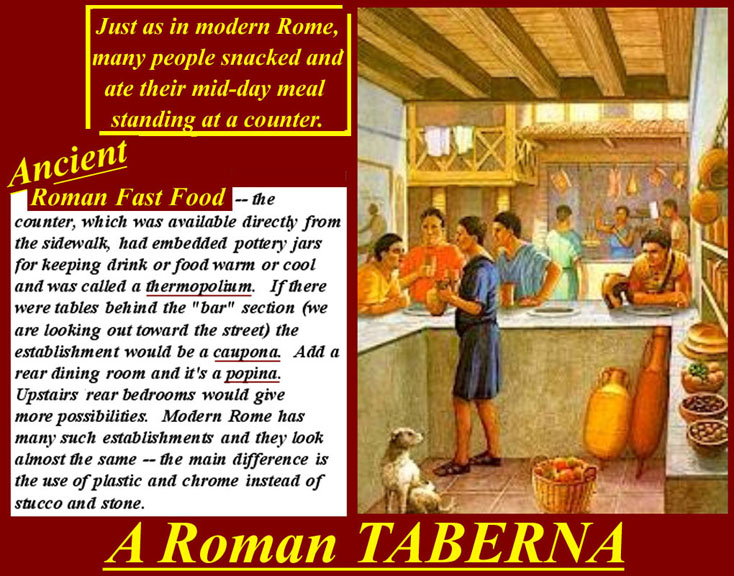
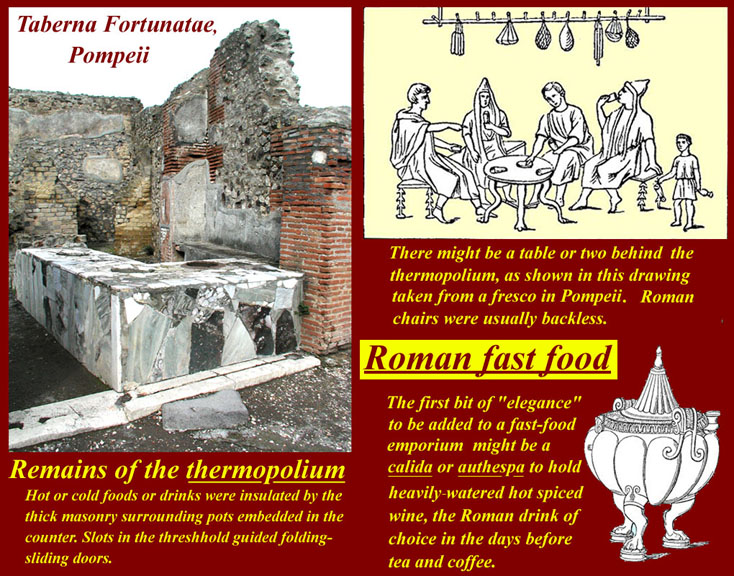
http://www.mmdtkw.org/03-08Taberna.jpg
http://www.mmdtkw.org/03-09TabernaFortunatae.JPG
http://www.mmdtkw.org/03-10RestaurVocab.jpg
Let's eat out tonight!
Almost everyone ate out or carried out all the time. Only a rich family in a domus would have its own kitchen, and even they would usually eat their main meal of the day, at about 11 AM, at some kind of fast food outlet -- they were out and about and wouldn't want to go home just to eat. Big evening meals might be served, especially for honored guests, in special rooms in houses called triclinia where three-person couches (also called triclinia) were grouped around small tables. But even those meals were likely to be catered.
Vast overindulgent banquets (sometimes referred to as "orgia") did occur, but onlt very seldom, and they were ridiculed as the pastime of the nouveau riche. "Trimalchio's Banquet" in the Satyricon of Petronius Arbiter was meant as a condemnation of the excess of the freedman, Trimalchio, and not as an example of how upper class Romans ate and lived. Overeating and over drinking, even being overweight, was declasse and contrary to Roman "virtus" (manliness, character). One of the propaganda devices used by Octavian against Mark Antony was revelation that he was overindulging in Alexandria -- something that no Roman with "virtus" should do.
Word History: The word orgy has become connected in our minds with unrestrained sexual activity, but its origins are much less licentious. the word can be traced as far back as the Indo-European root *werg-, meaning "to do," also the source of our word work. Greek <orgia>, "secret rites, worship," comes from *worg-, one form of this root. The Greek word was used with reference to the rites practiced in the worship of various deities, such as Orpheus and Dionysus. The word in Greek did not denote sexual activity, although this was a part of some rites; the rites of Dionysus, for example, included only music, dancing, drinking, and the eating of animal sacrifices. Romans mockingly applied the word orgia to overindulgent eating and drinking. Having passed through Latin and Old French into English, the word orgy is first recorded in English with reference to the secret rites of the Greek and Roman religions in 1589. It is interesting to note that the word is first recorded with its modern sense in 18th-century English and perhaps in 17th-century French. Whether this speaks to a greater licentiousness in society or not must be left to the historian, but now the religious nature of the word has gone into eclipse.
http://www.mmdtkw.org/03-11EdibleDormouse.jpg
The Romans ate the European dormouse (myoxus glis), a small rodent species that still inhabits large parts of Europe, Asian Turkey and Syria. They are about the size of American grey squirrels and look much like them except for a slightly less bushy tail. They will eat meat if they must, but prefer to be herbivores. They are no longer eaten in Europe, but only because they are a protected species, too many of which were eaten in the past. They are said to taste like chicken.
Most of the dishes described in Trimalchio's Feast in the Satiricon Liber of Caius Petronius Arbiter were probably made up as examples of the supposed excesses of Rome's newly rich freedmen. Most Romans were abstemious eaters and drinkers (always, for example, watering their wine) either because of the virtu required of the Roman upper classes or because of the poverty of the lower orders.
Clothing
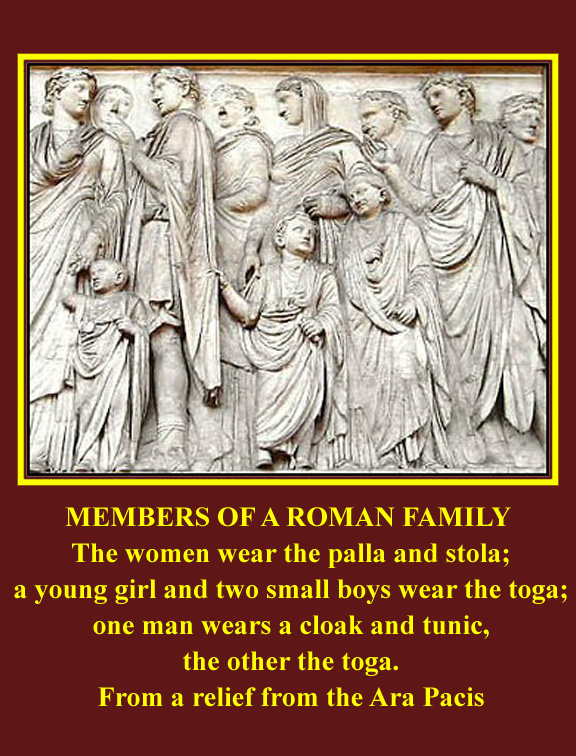
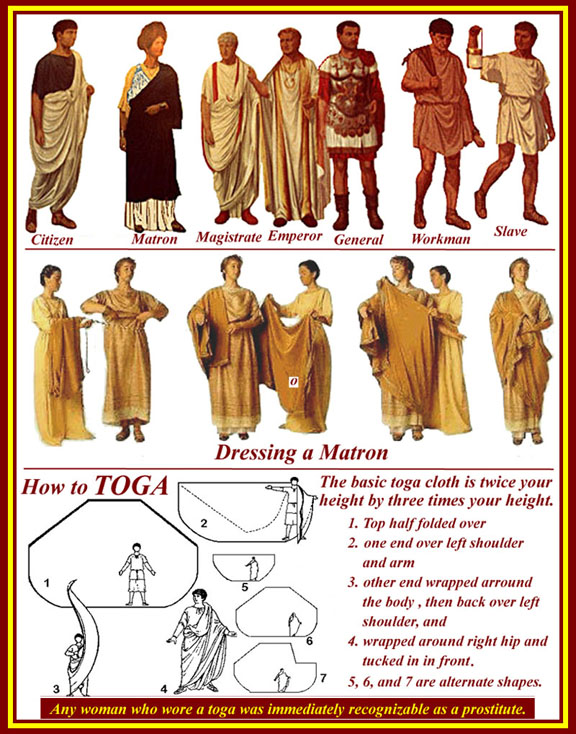
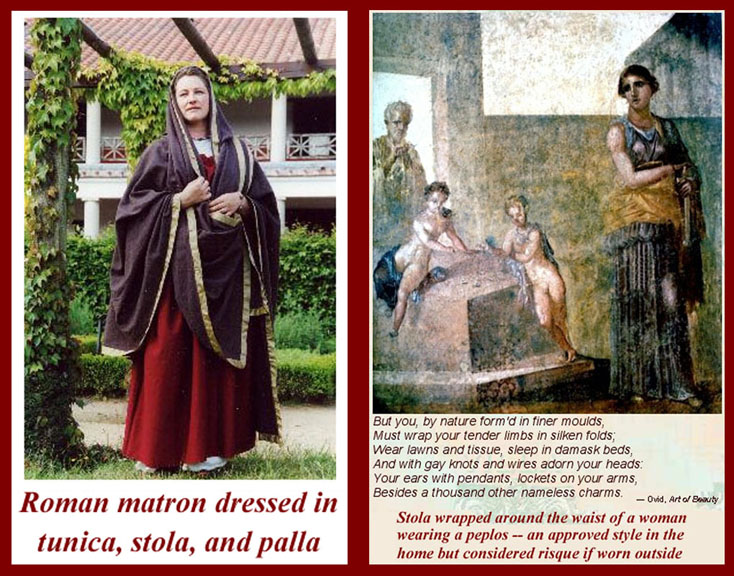
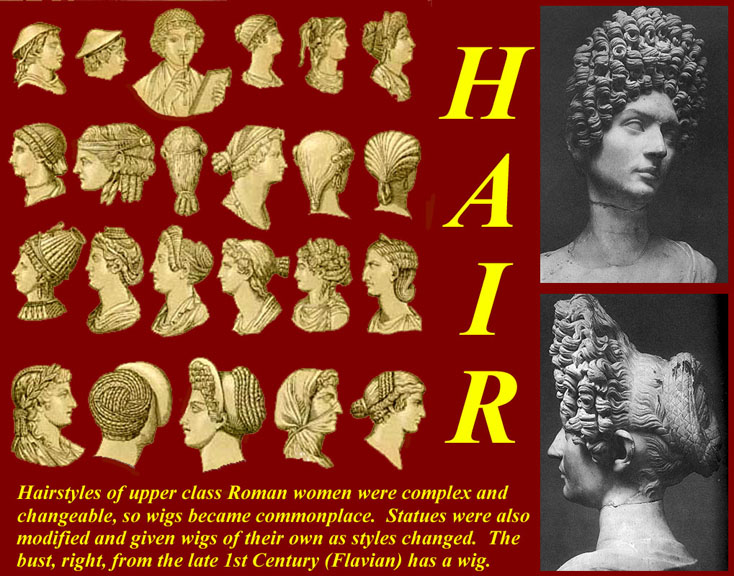
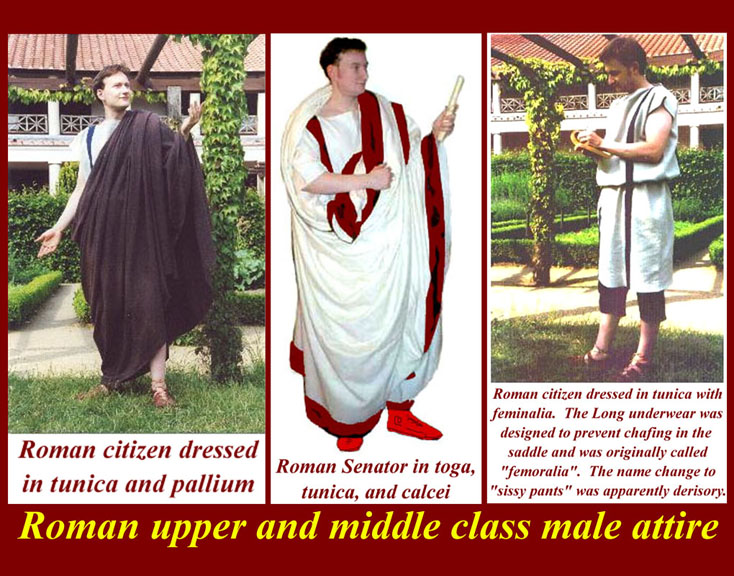
http://www.mmdtkw.org/04-01Family_Clothing.jpg
http://www.mmdtkw.org/04-02RomanDressing.jpg
http://www.mmdtkw.org/04-03MatronAttire.jpg
http://www.mmdtkw.org/04-04WomenHair.jpg
http://www.mmdtkw.org/04-05MaleAttire.jpg
http://www.mmdtkw.org/04-06Footware.jpg
Roman clothing styles, especially elite men's and women's ceremonial styles were remarkably stable. How one dressed and how well one wore the traditional toga (men) or stola and palla (women) said much about your social status and maturity. A male citizens put on his first toga (became "togatus") at puberty in a special ceremony, and a woman would adopt matronly garb when first married. In earliest times, women also wore togas, but at least by the time of the Republic and ever thereafter, the only "togata" women were whores. The toga was too heavy and bulky for hard work or for military activities. Soldiers wore the red military cloak, the sagum. Going to war was called "putting on the sagum". Making peace was "changing from sagum to toga".
Fashion details did change; elaborate hair styles for women made wigs popular -- even statues were made to allow for changing of their marble hairstyles. Many different shoe styles are attested, with one particular style (red with crescent shaped ornamental buckles) reserved for senators an magistrates. Sumptuary laws also, early on, limited the toga to Roman citizens. Later Roman togas were much smaller and eventualy shrunk to the size of a one-shoulder cape, the sole purpose of which was to identify a Roman citizen.
Education
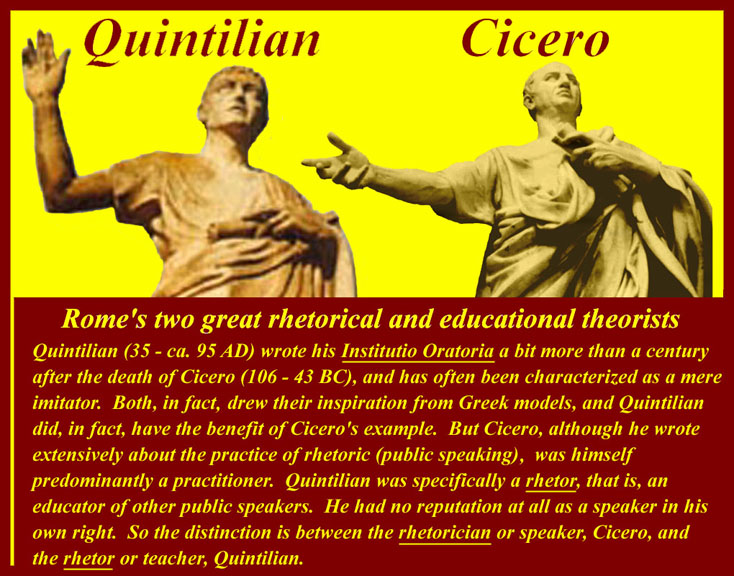
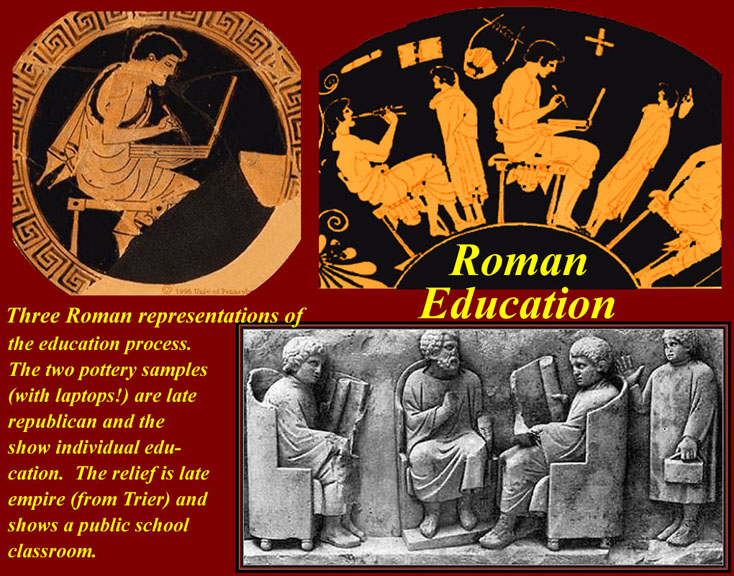
http://www.mmdtkw.org/05-01QuintilianCicero.jpg
http://www.mmdtkw.org/05-02RomanEducation.jpg
http://www.mmdtkw.org/05-03RomanSchoolBrutality.jpg
A well educated Roman male would be expected to be trained in rhetoric, the highly stylized act of public speaking. Teachers of rhetoric were known as rhetors, and they would take over male education after the basics (yes, the three Rs) were taught in private schools or by private tutors and gramatici. All the best families employed tutors and gramatici, who often were skilled and well educated foreigners. The job of the tutor was to get the student up to speed on education, social and military matters, although for the latter they might take their student to a military professional. If enough money was available, the student would also be taken to sports professionals -- paelestra sports were necessary for a well rounded individual. The tutor would also often oversee the student's sexual initiation, sometimes starting with a tutor-student homosexual relationship but, to be acceptable, ending with heterosexual experiences before or at puberty. Upper class girls would be educated until they could read and write and oversee family and sometimes business accounting. A girl who could speak Greek as well as educated Latin would fetch a larger dowry -- as long as she knew her place. Education, especially in the schools but also by tutors could be brutal. As was later the case with European nobility and royalty, teachers were empowered to enforce discipline over their students, who were technically their social betters.
Reading and writing
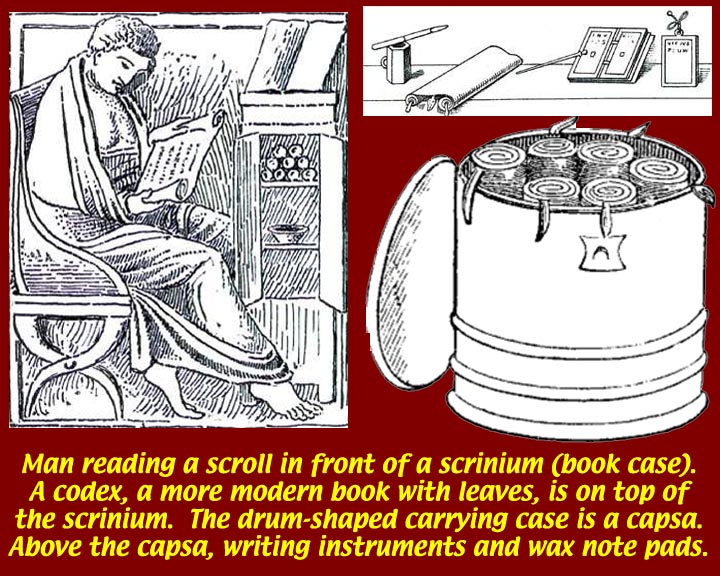
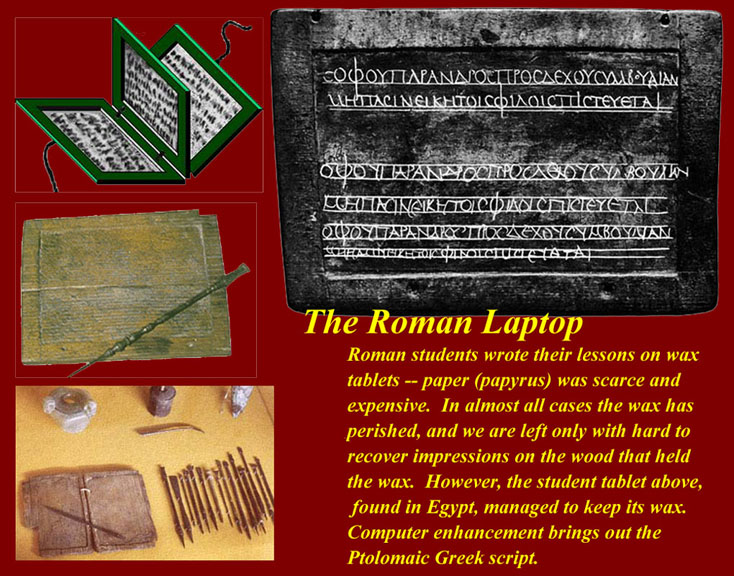
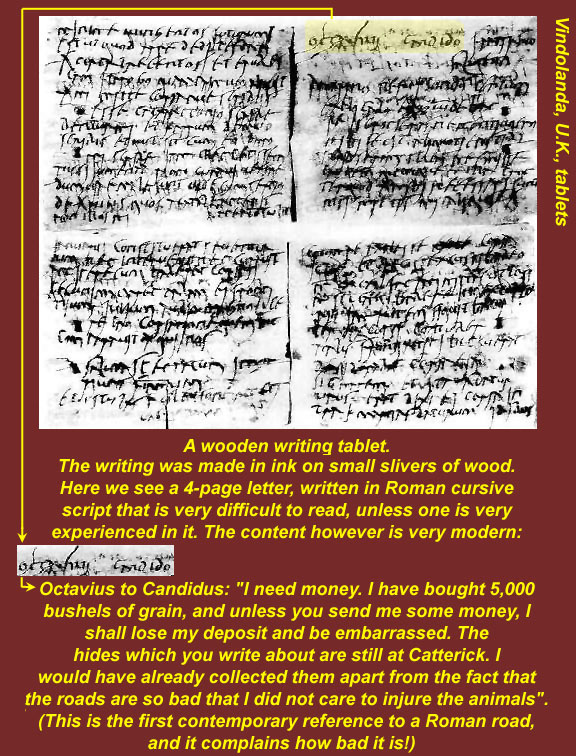
http://www.mmdtkw.org/05-04aScrollBook.jpg
http://www.mmdtkw.org/05-04WaxTabletLaptop.jpg
http://www.mmdtkw.org/05-05VindolandaDoc.jpg
http://www.mmdtkw.org/05-06PoliticalGrafitti.jpg
Books were either scrolls or codexes. A book might include a whole series of scrolls perhaps kept together in a drum-shaped capsa or in a book case or scrinium like the one in front of our reader in the first image above. Scrolls could be large and long; Ani's Egyptian Book of the Dead ran to 74 feet. A codex was more like our modern books, made up of bound leaves. Originally codex meant "block of wood" because the leaves were thin sheets of wood. After papyrus and vellum became available, codexes were easier to handle. A codex was always easier for the reader to use (random access to pages) but it was harder to manufacture. Short communications, notes, and letters were often inscribed on wax tablets, some of which could be folder over to protect the writing during transport. Unlike scrolls which were written in columns arrayed side by side, the wax tablets were inscribed from top to bottom -- the second image above shows how they were written. Wax tablets were reused, and, at any rate, the wax would be gone by now. Nonetheless, modern imaging technology makes it possible to read some of the tablets because impressions sometimes carried through to the wood substrate. The third image shows examples of the "Vindolanda documents". Vindolanda was a Roman military outpost in England at which were found many letters and communications that were written in in ink on standard size sheets of wood. Most are personal letters from the troops to Roman families or from families to the troops. The fourth image shows some of the hundreds of political graffiti that were found on the walls of Pompeii; a political campaign for local magistracies was under way when Vesuvius buried the city.

